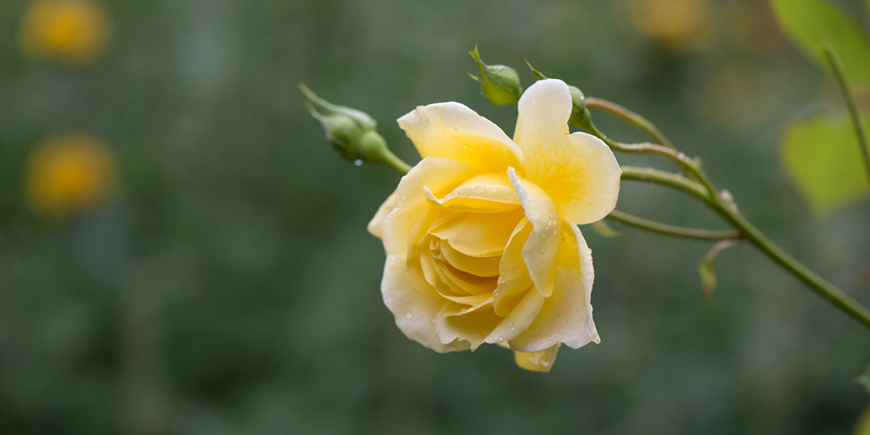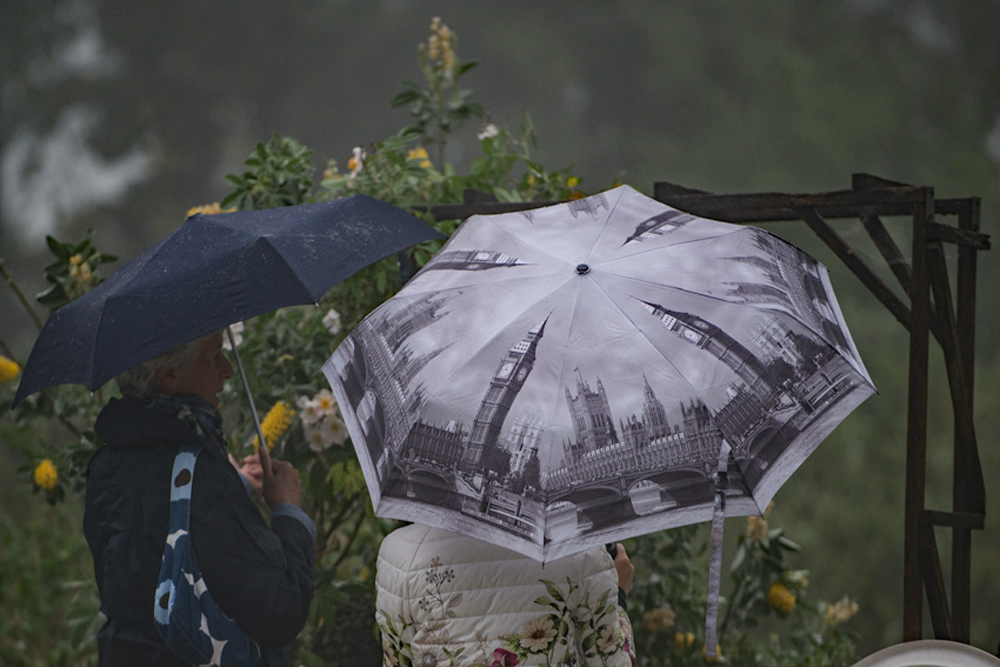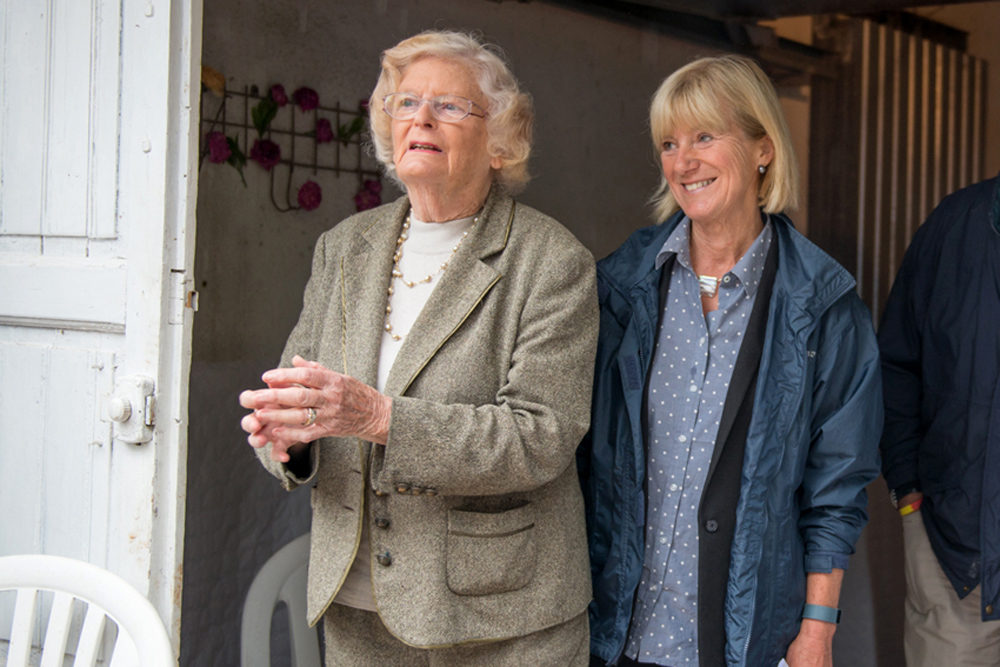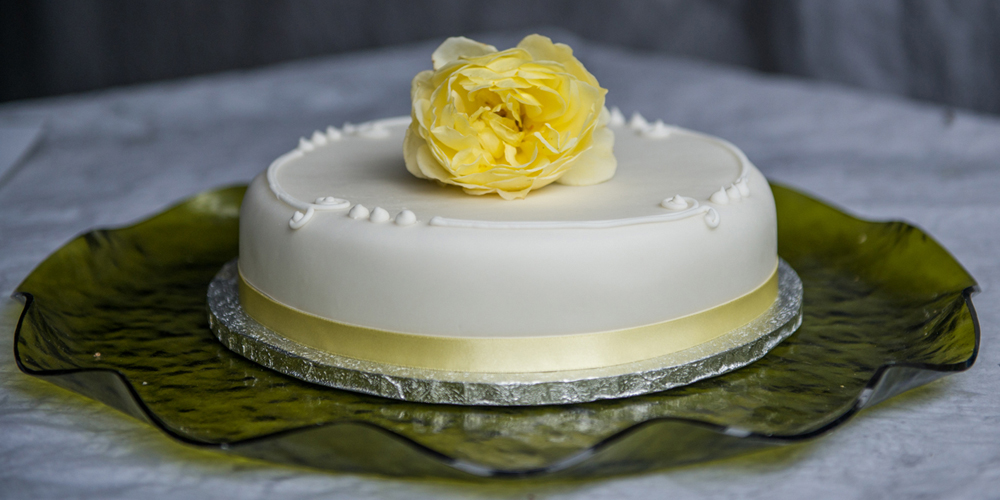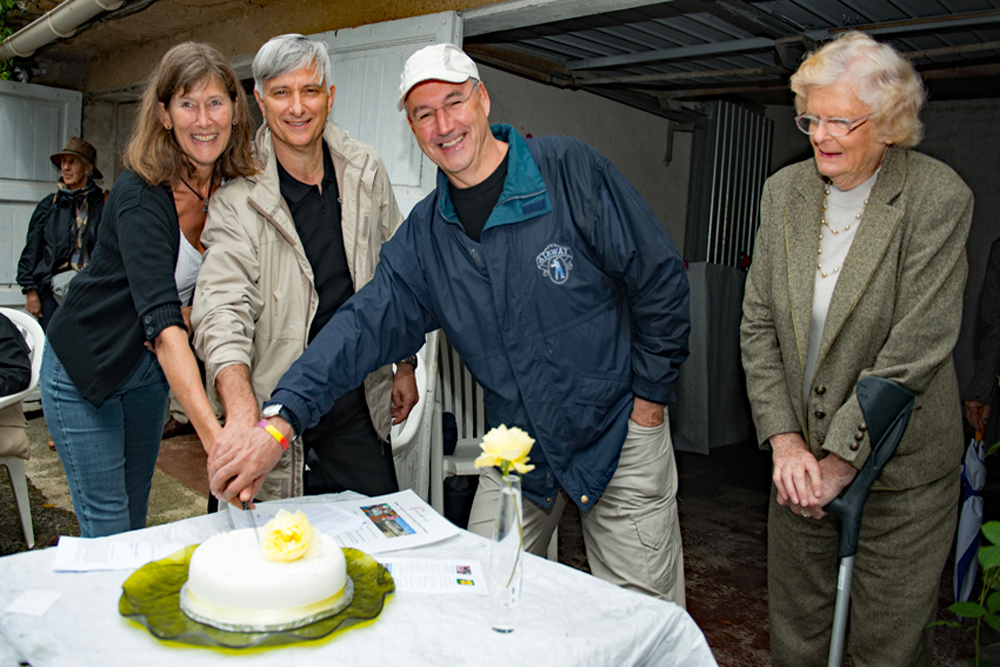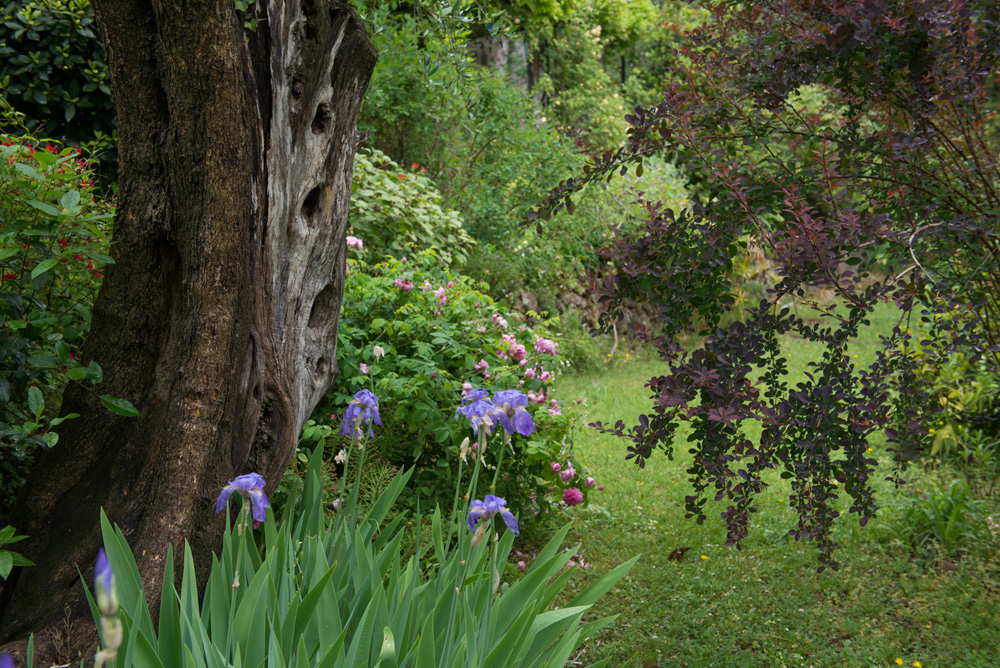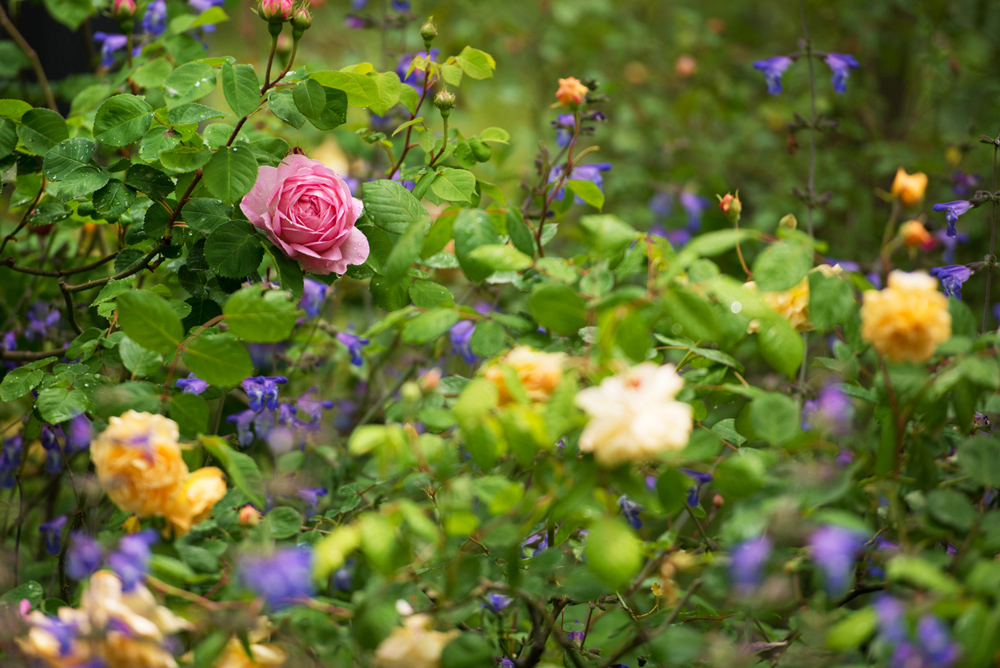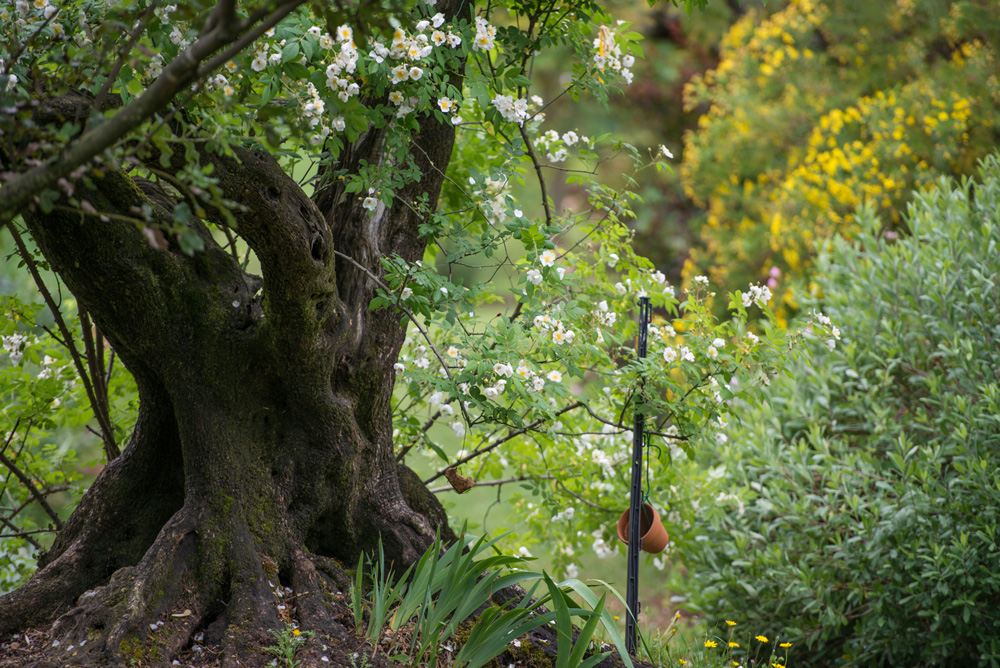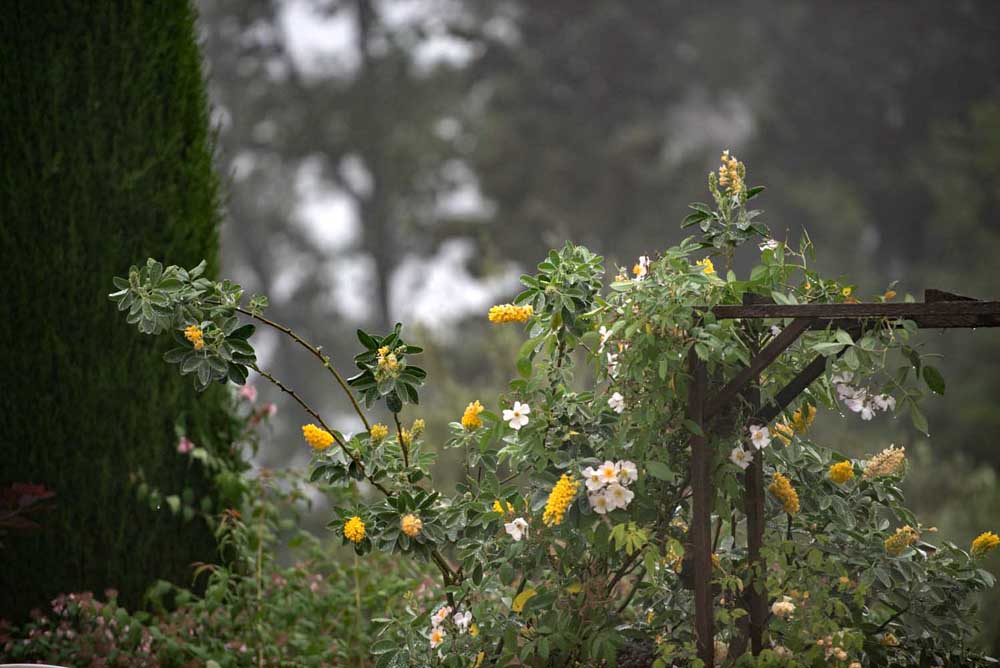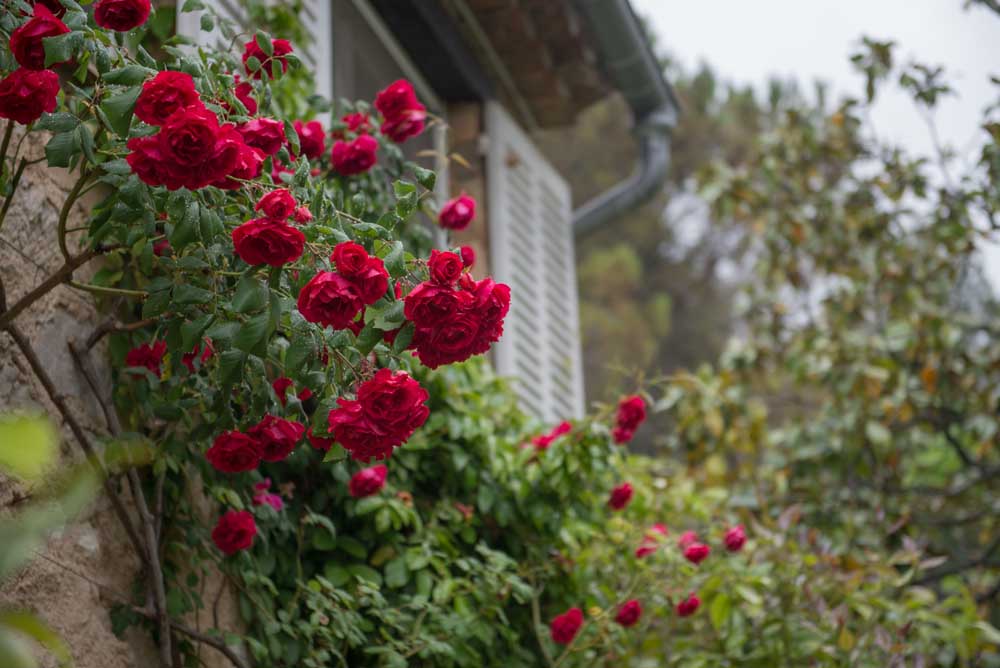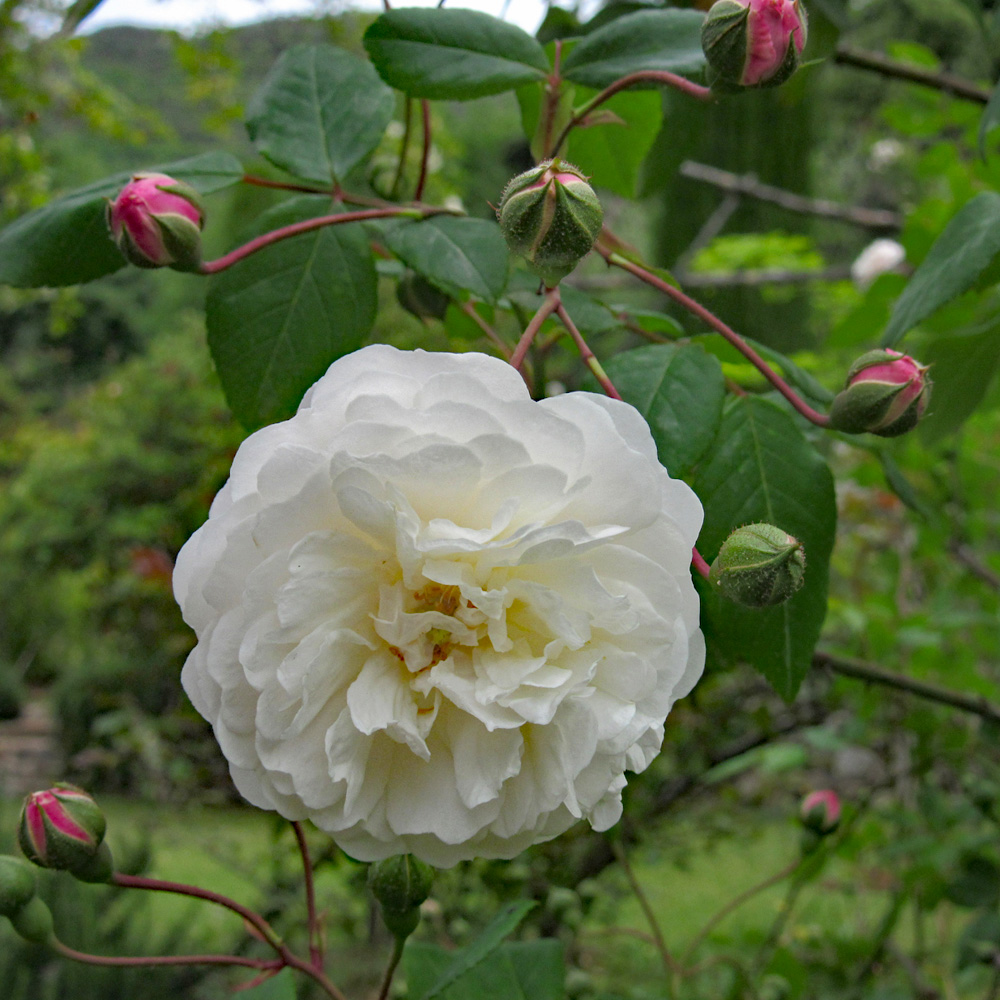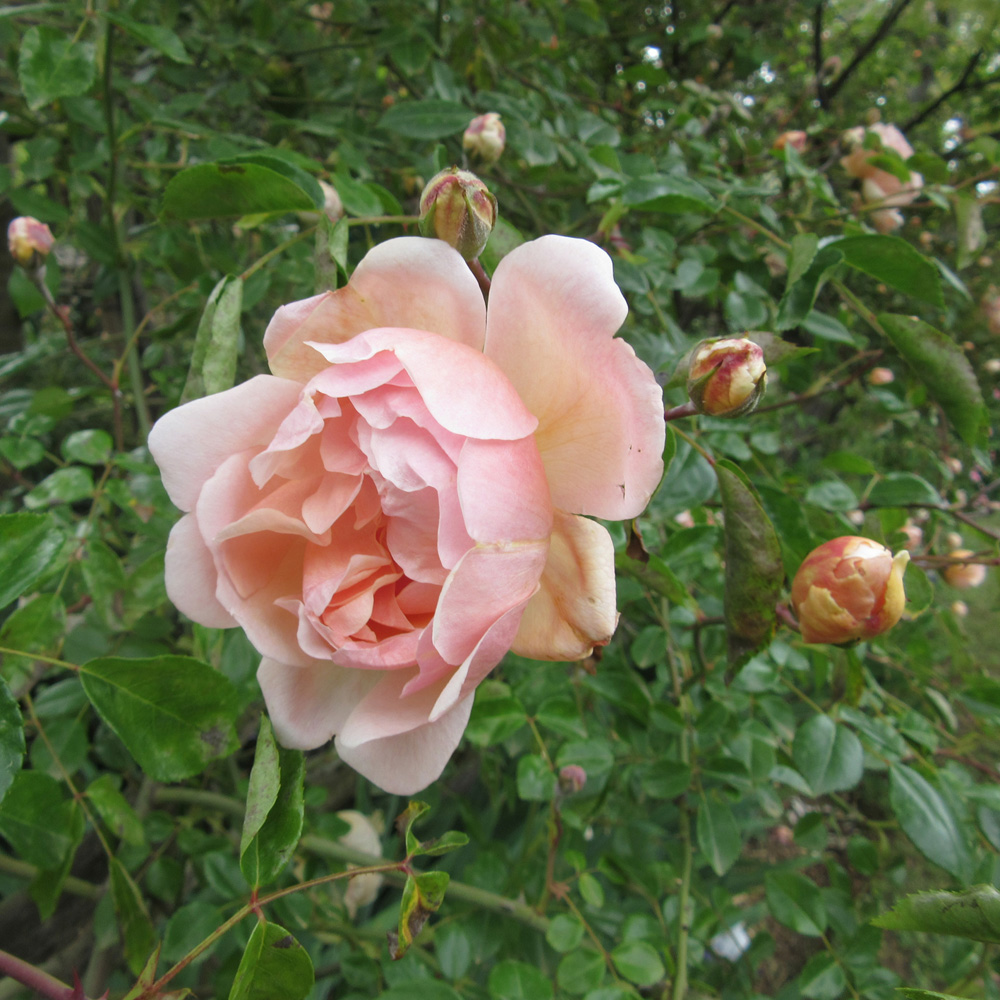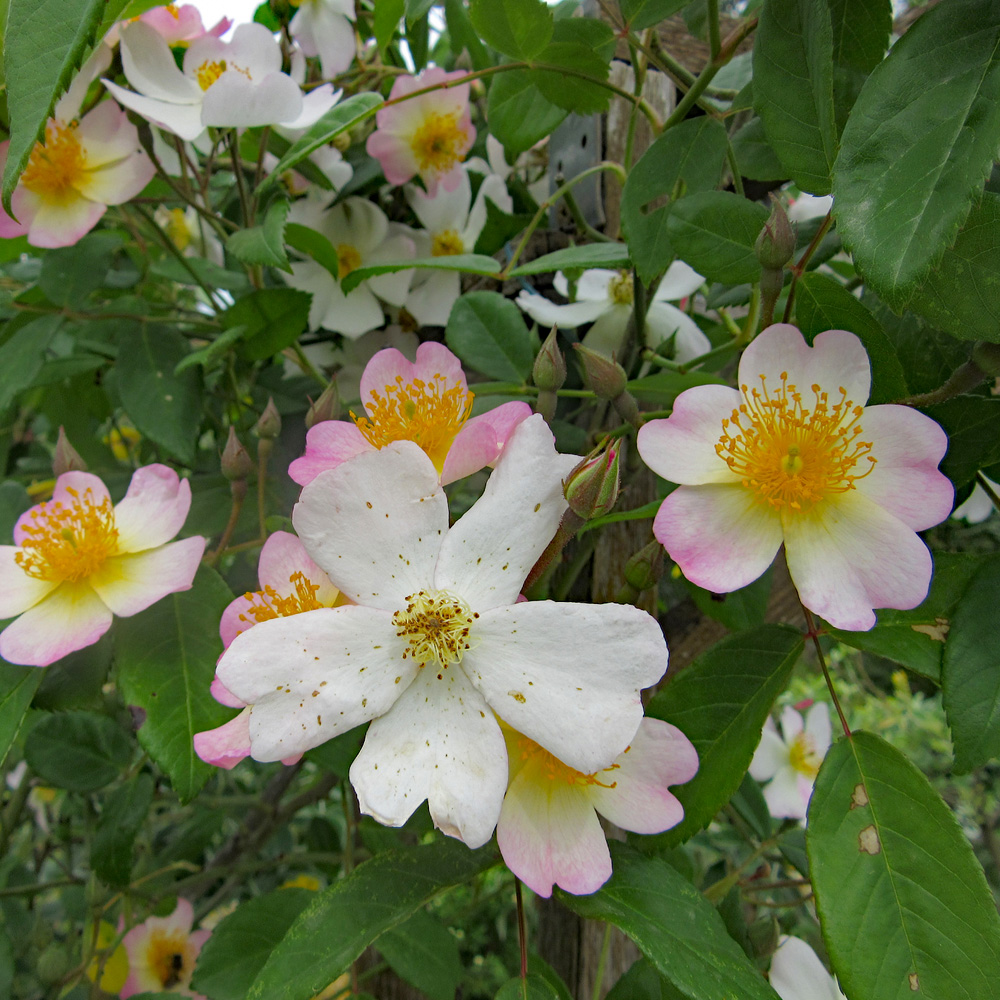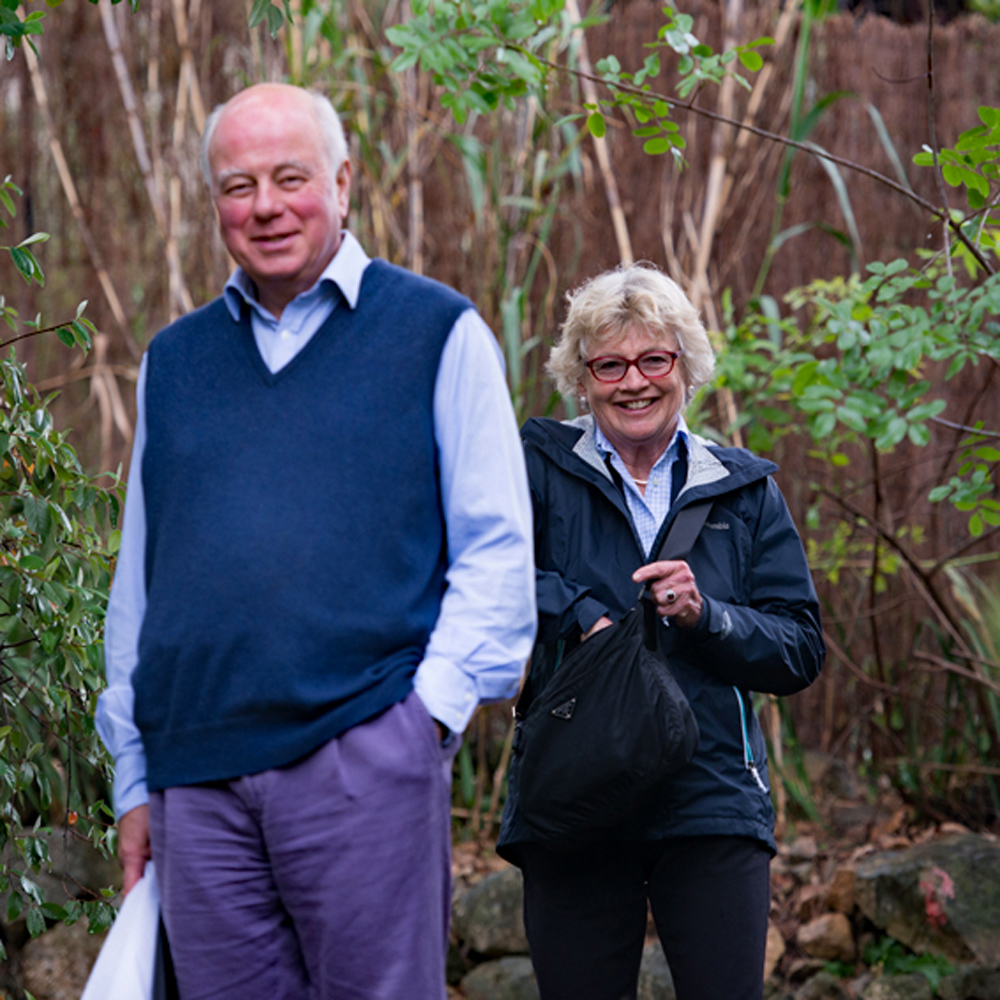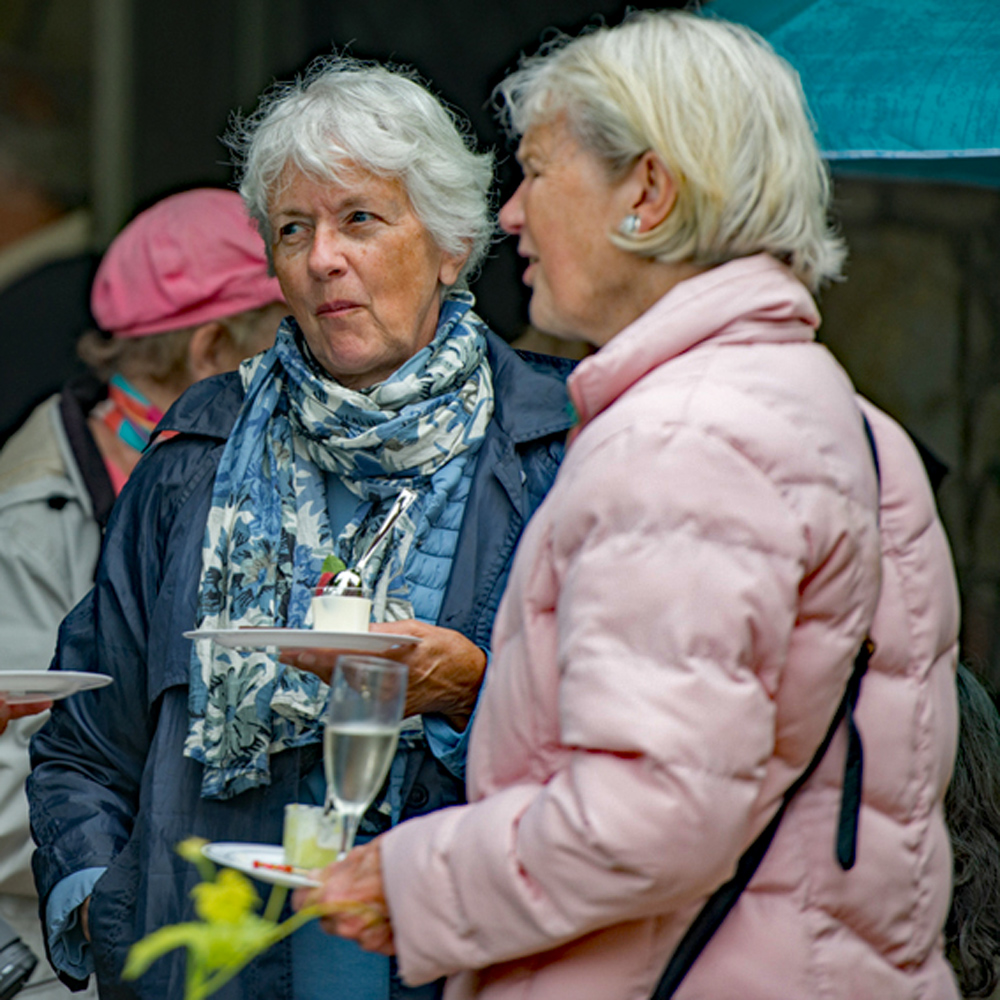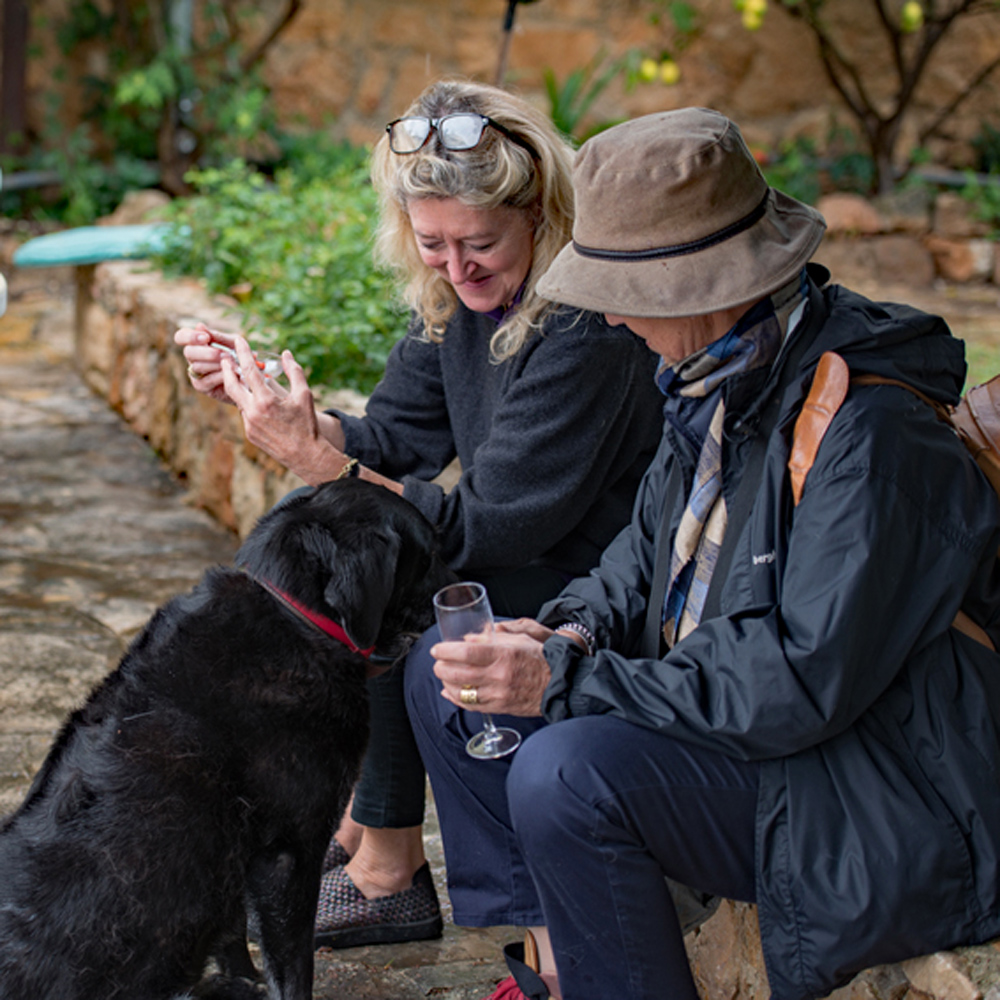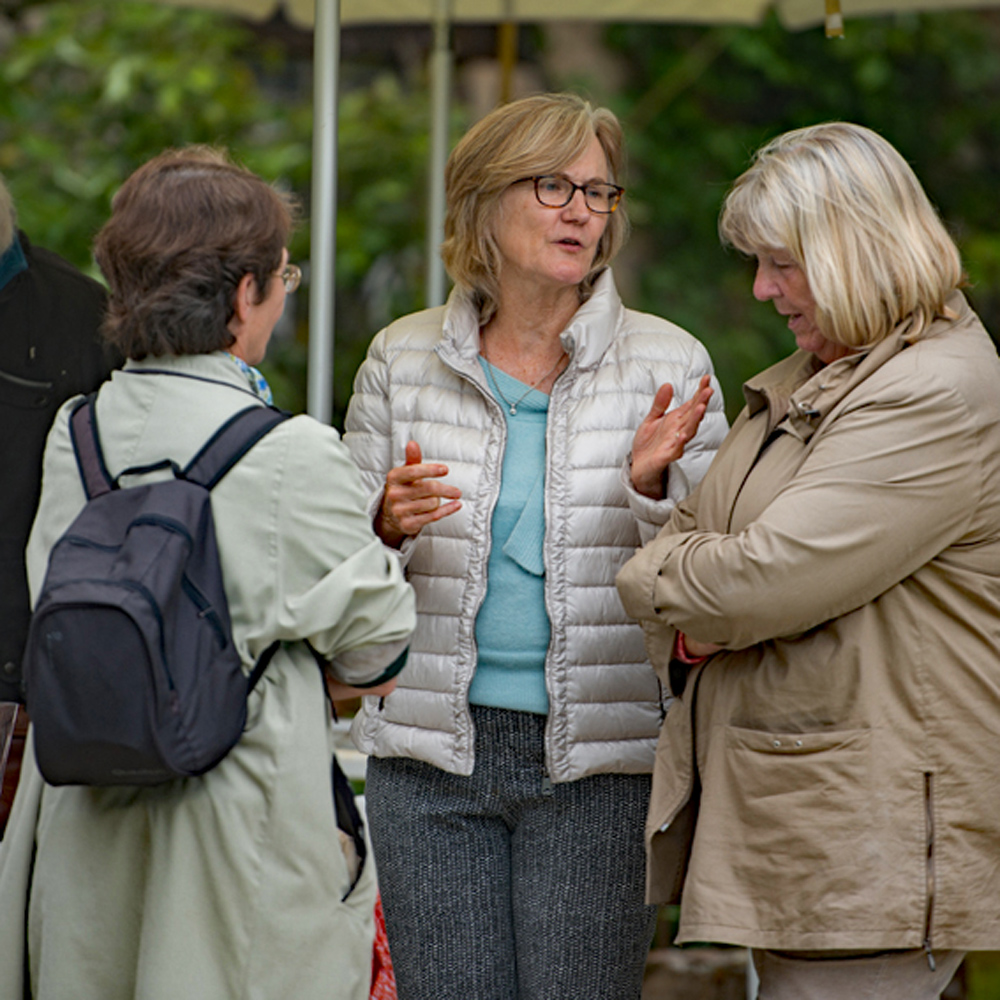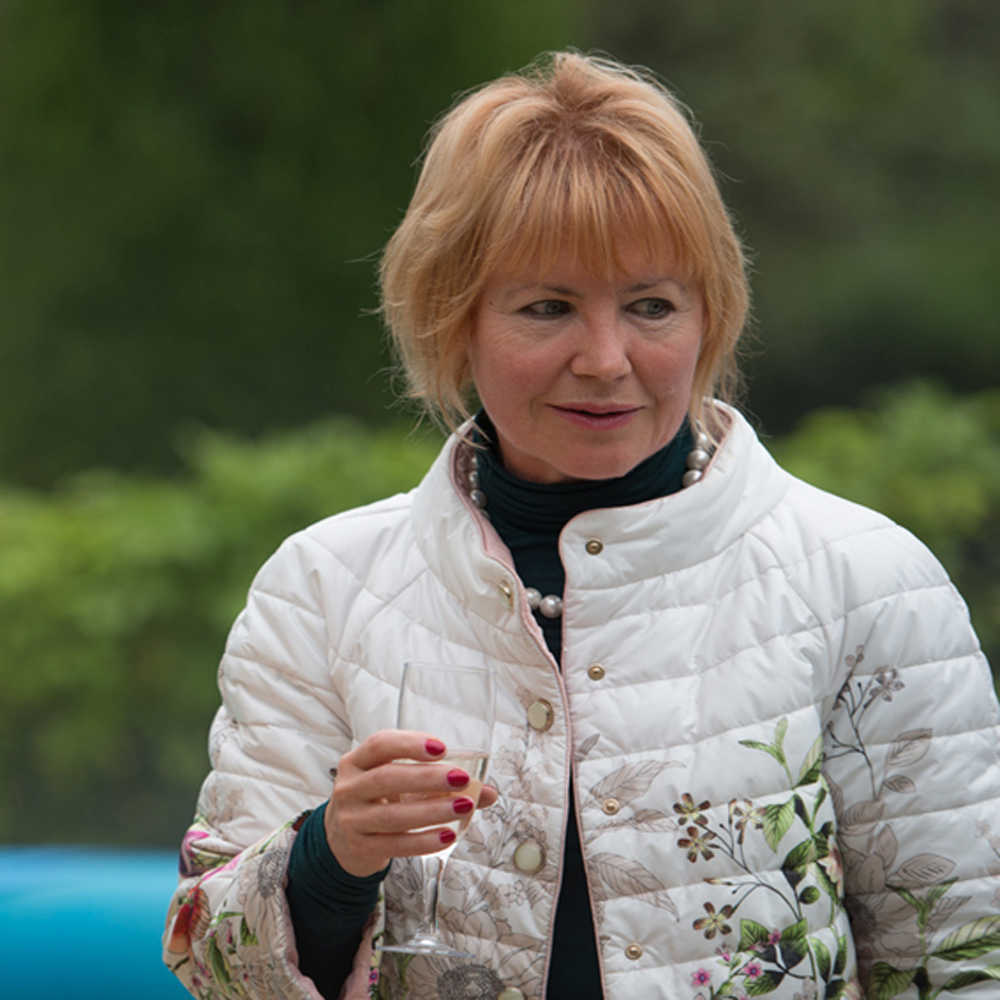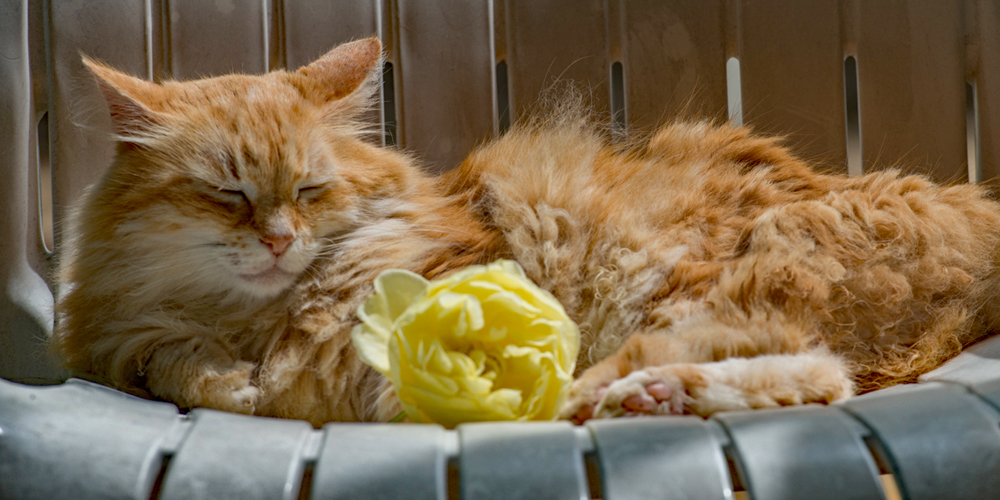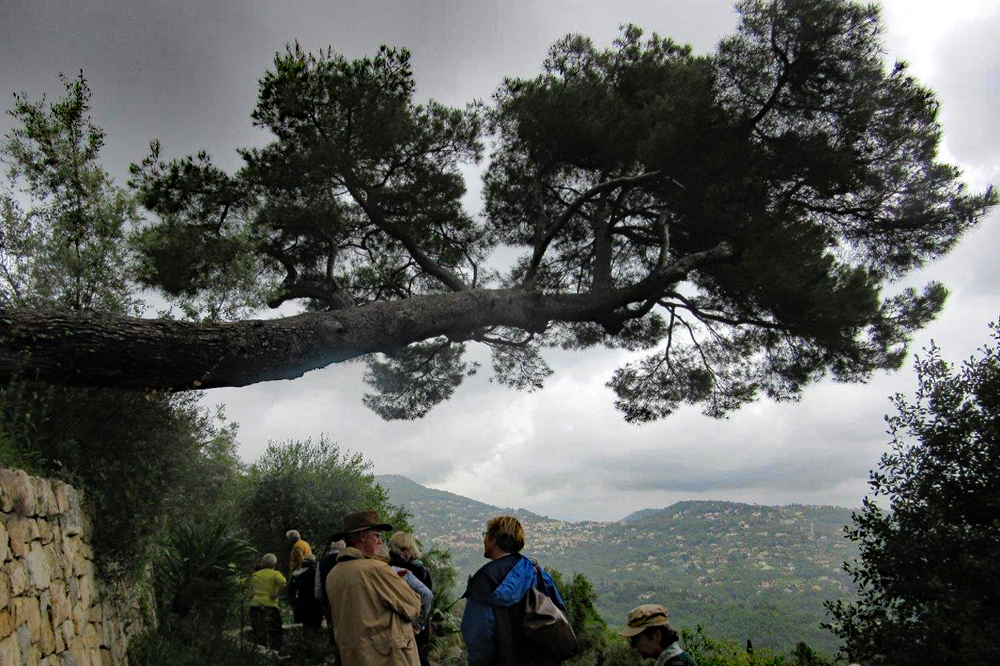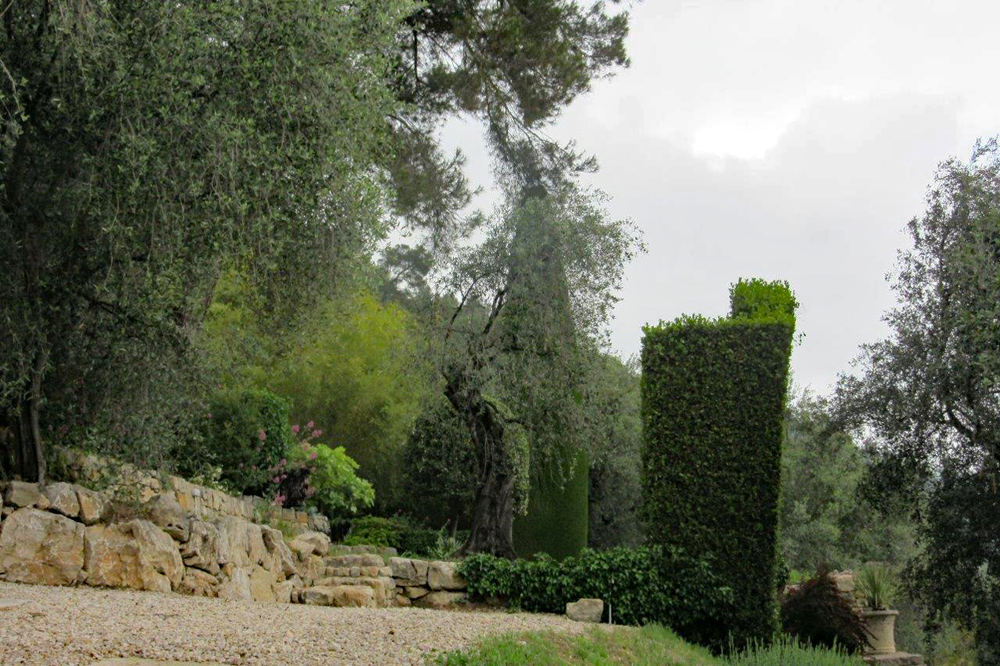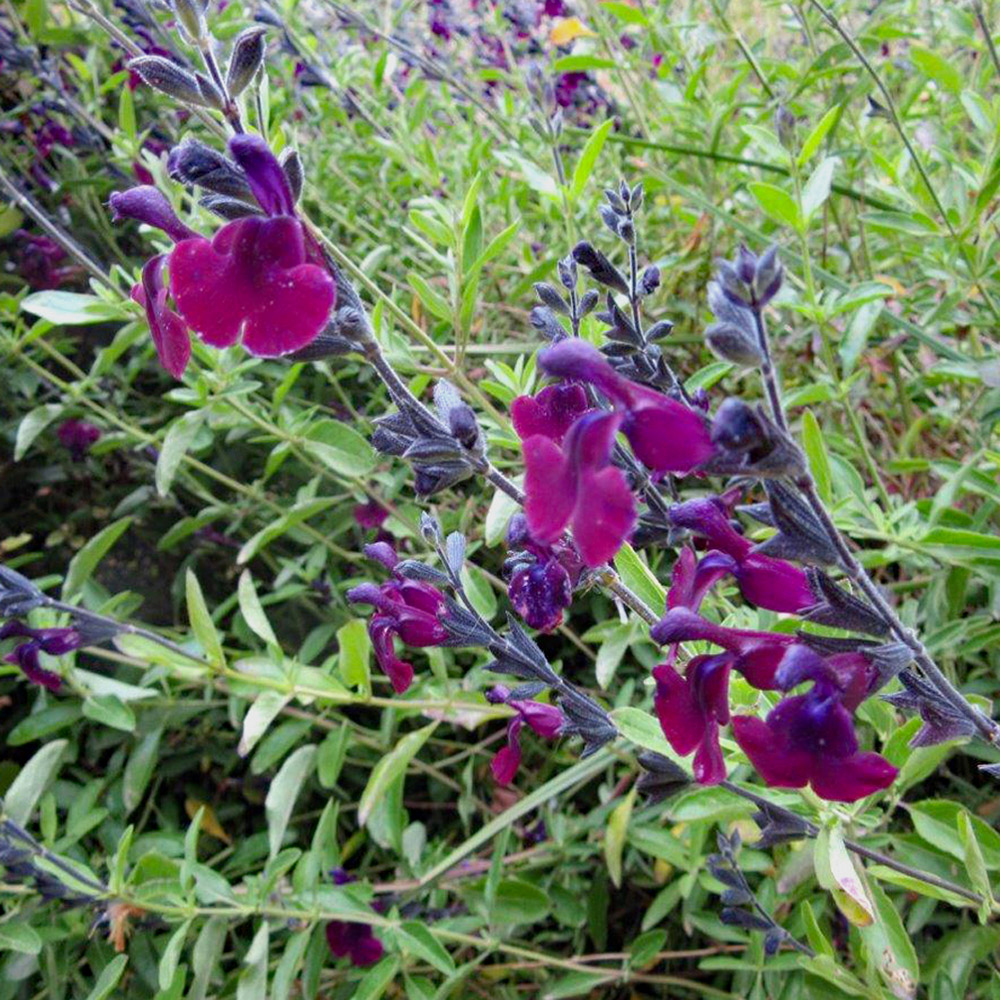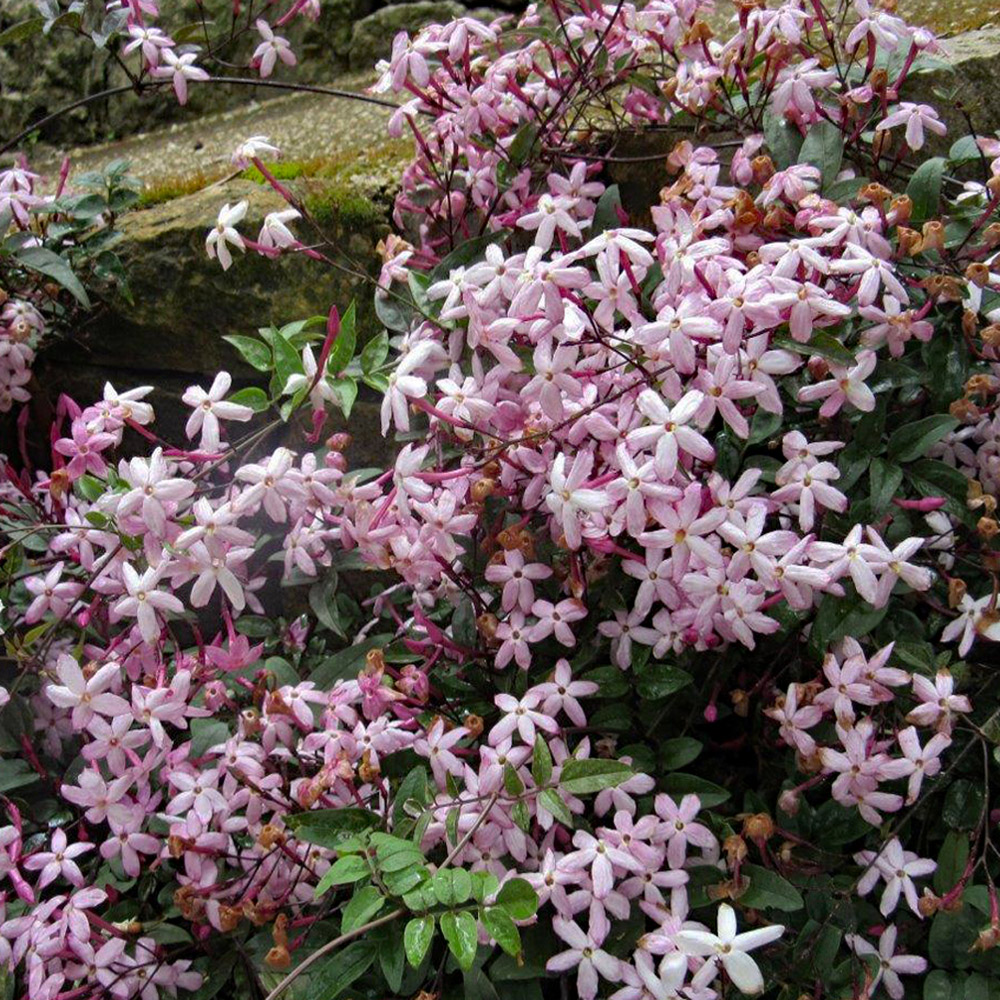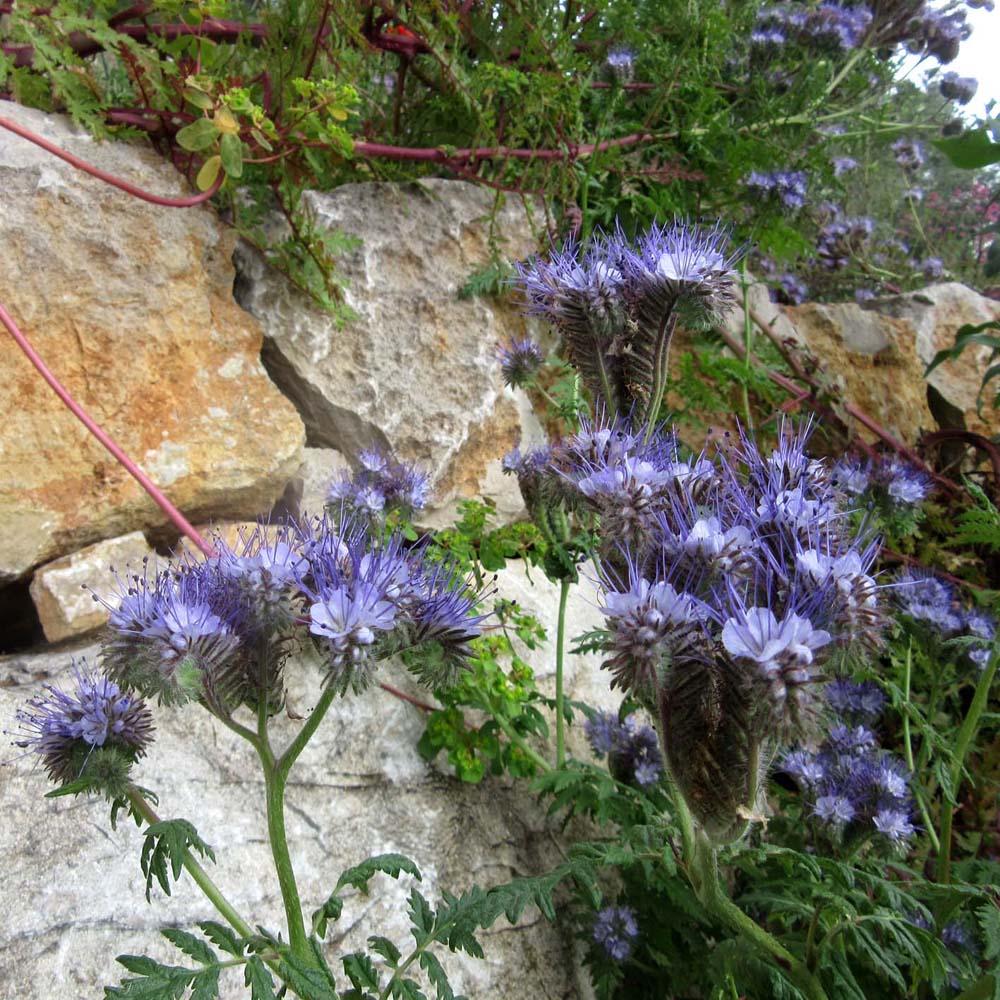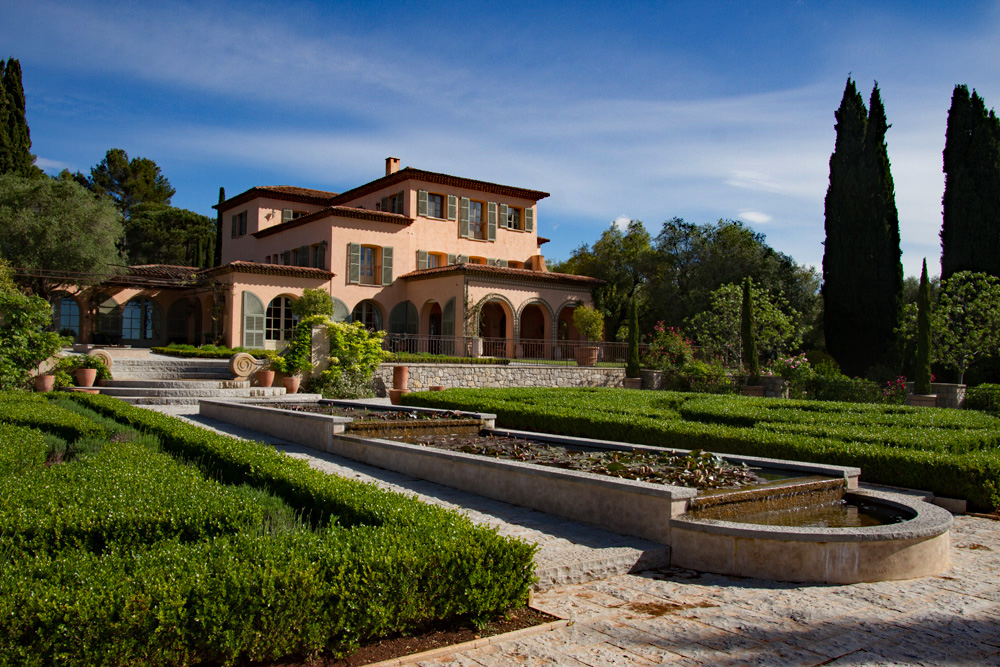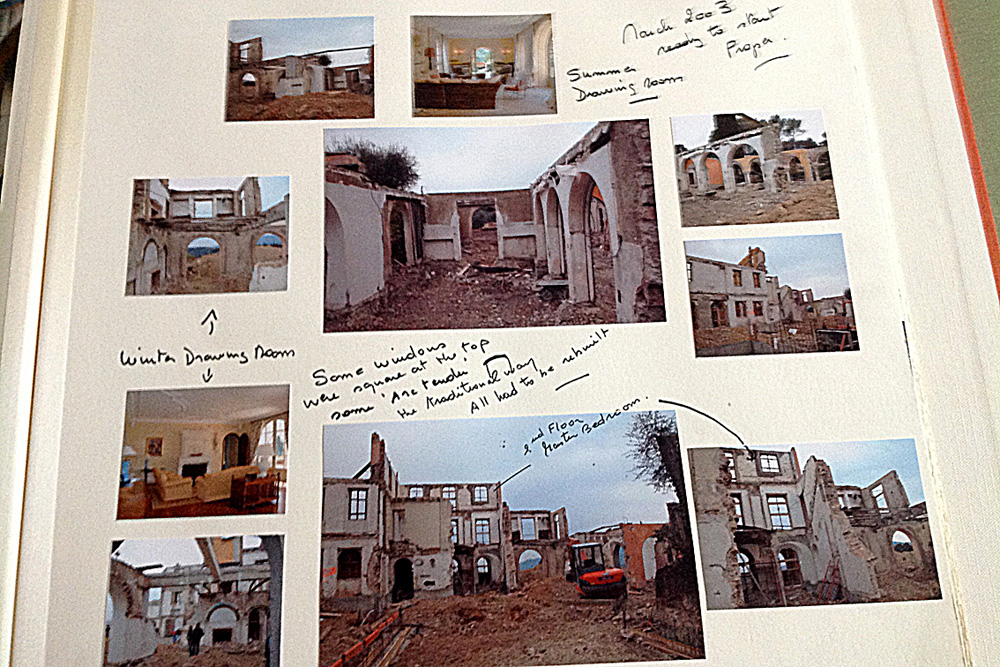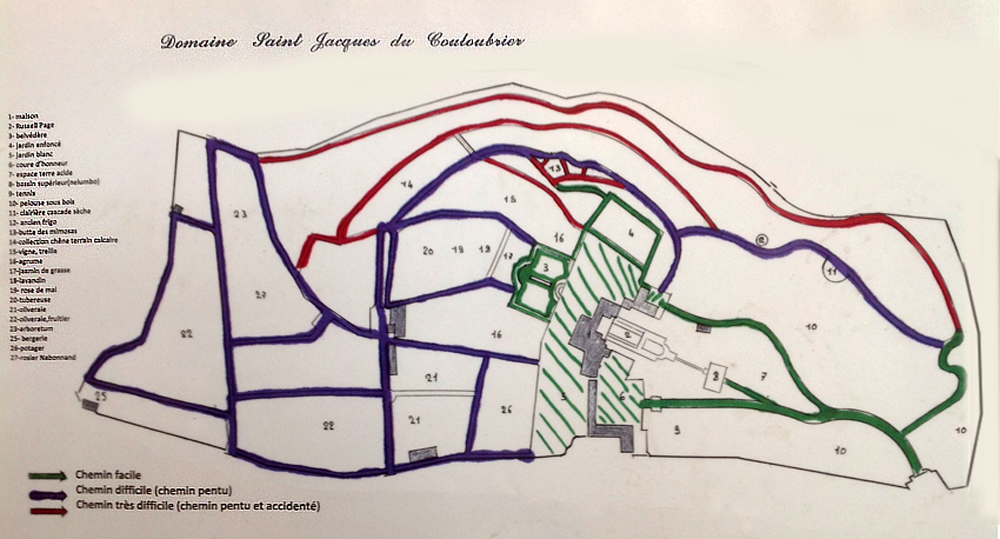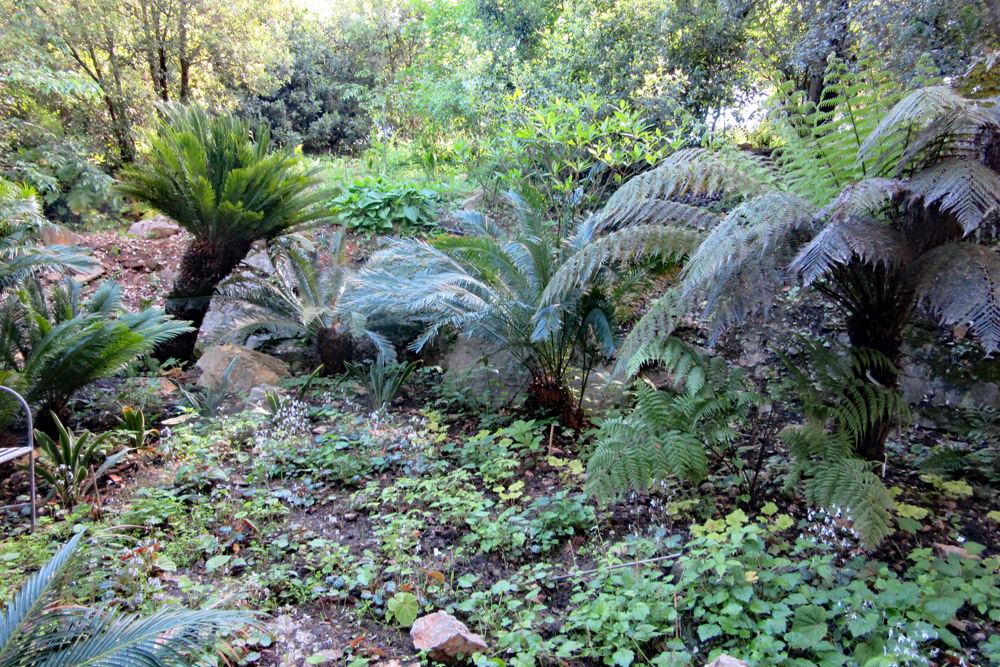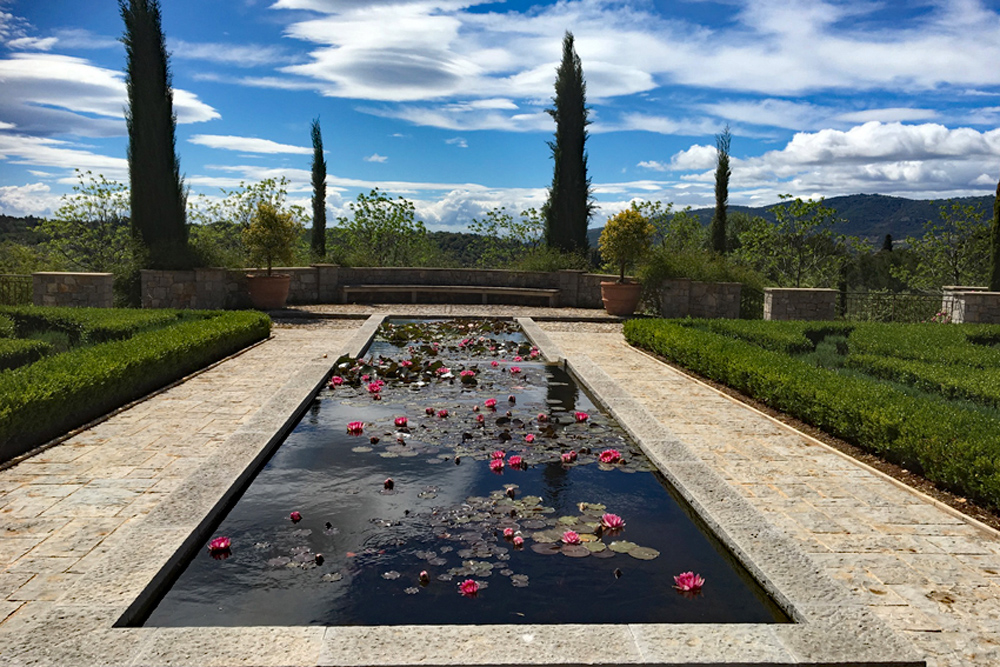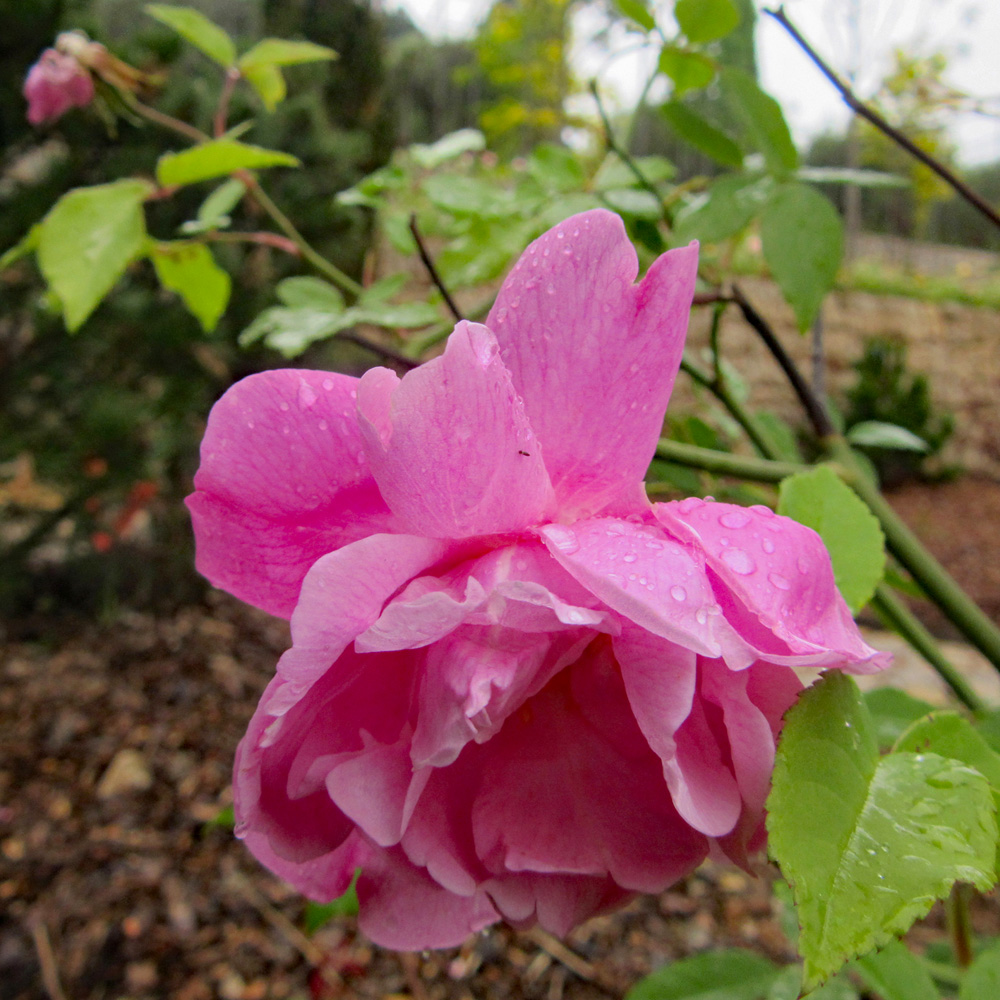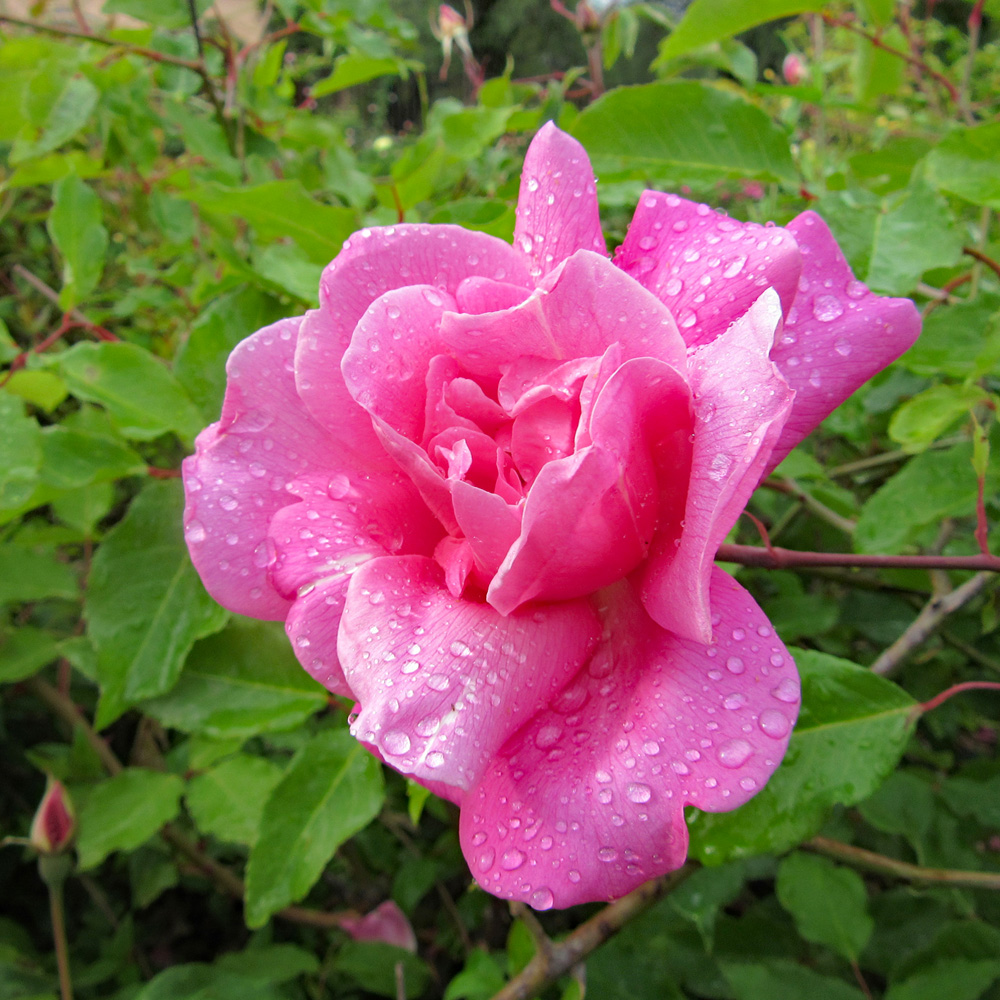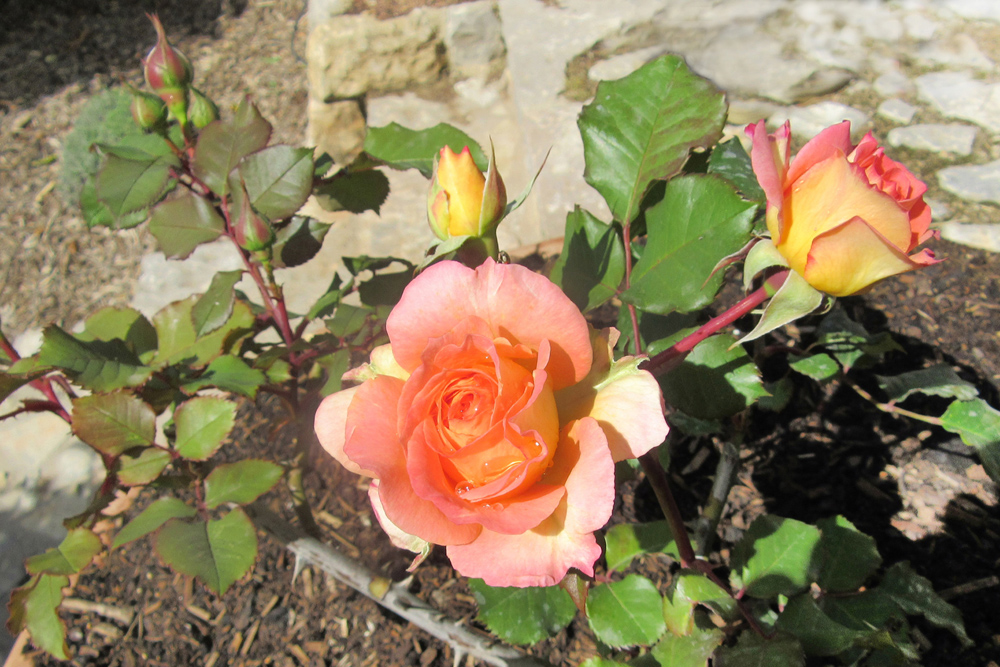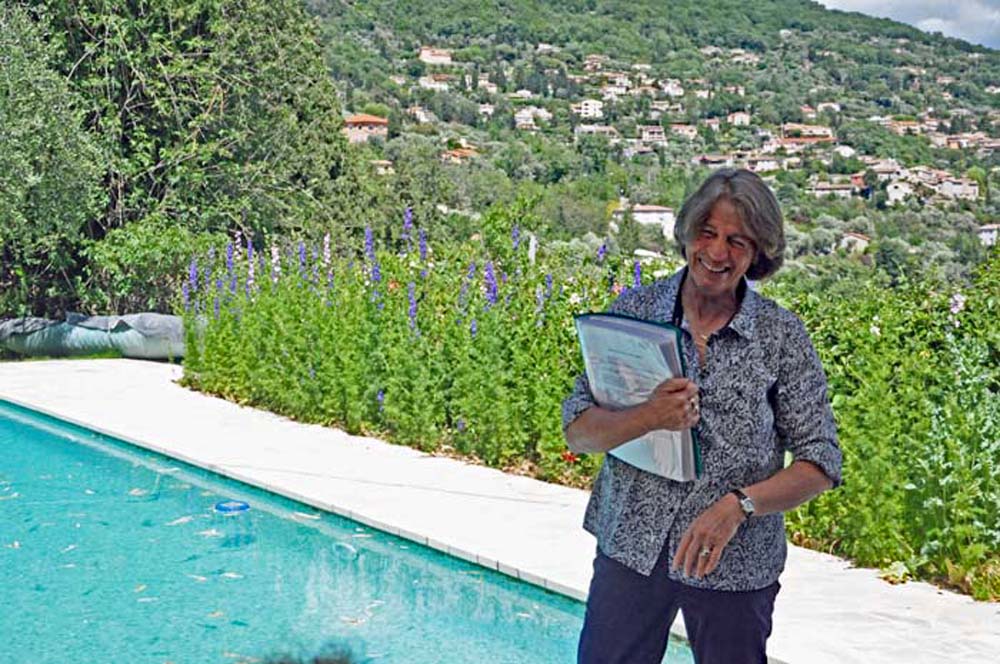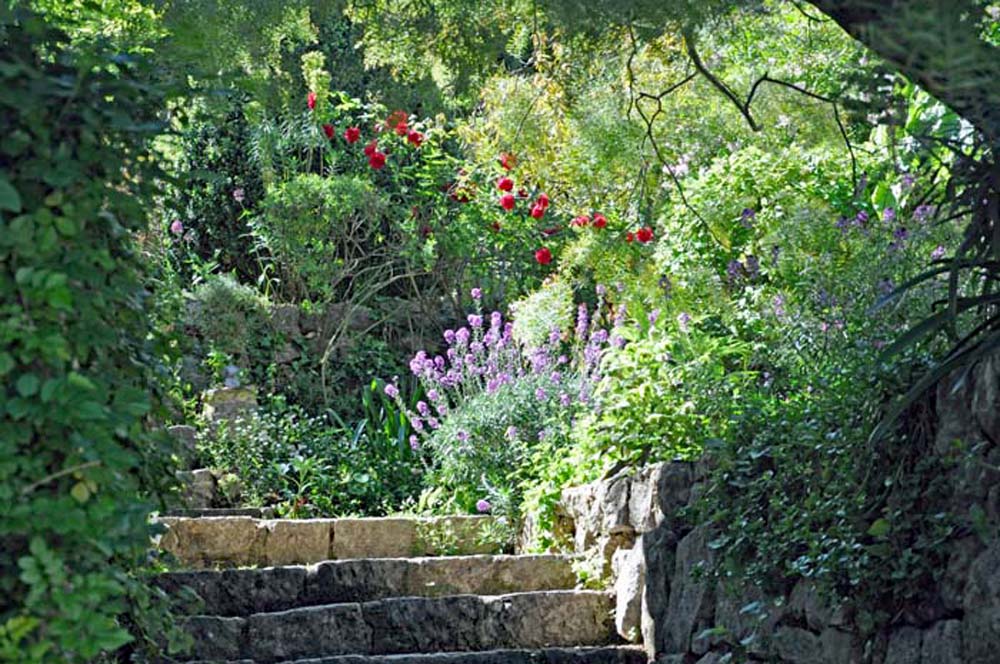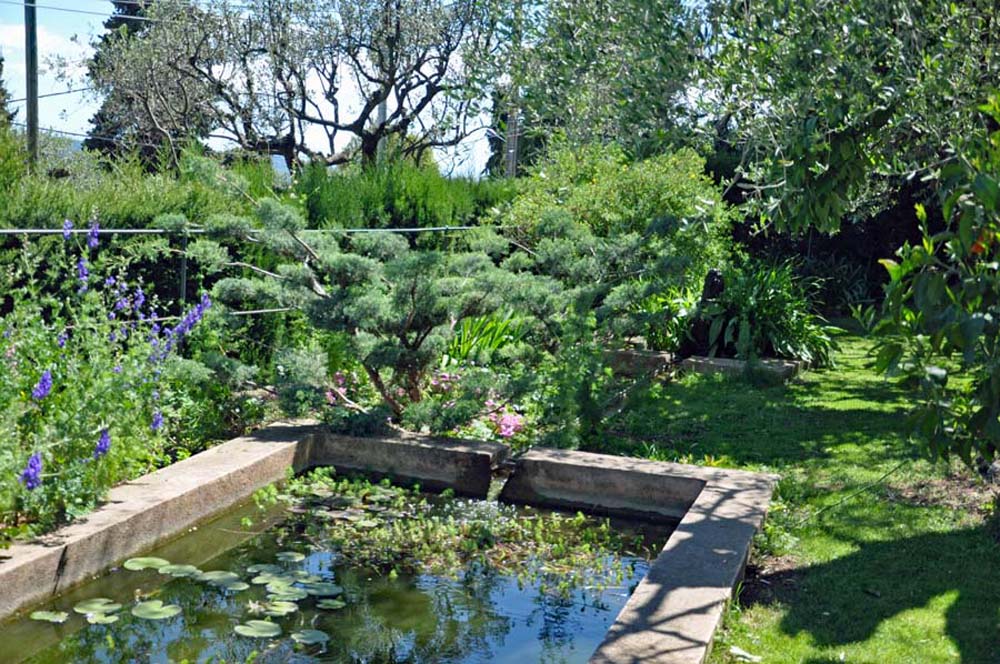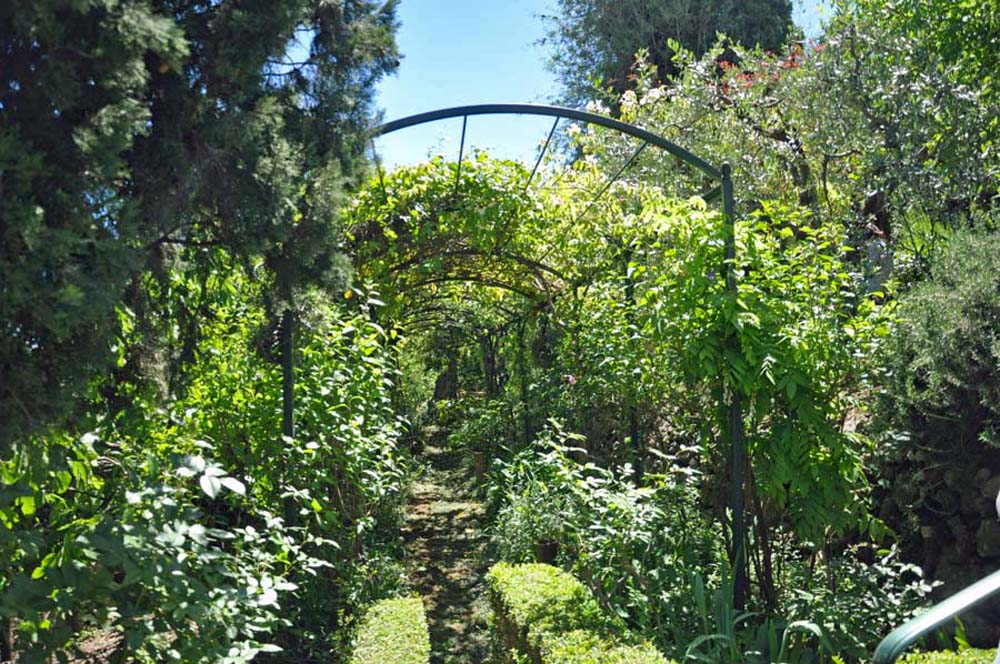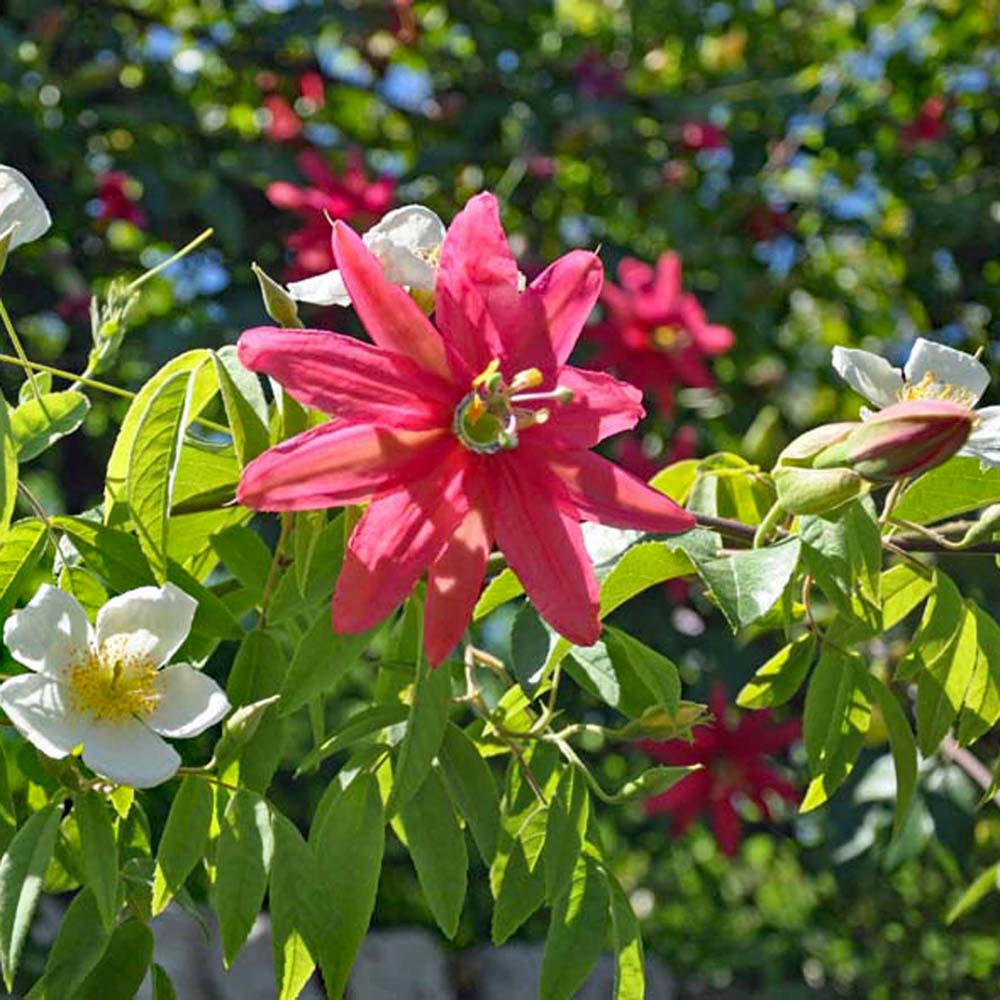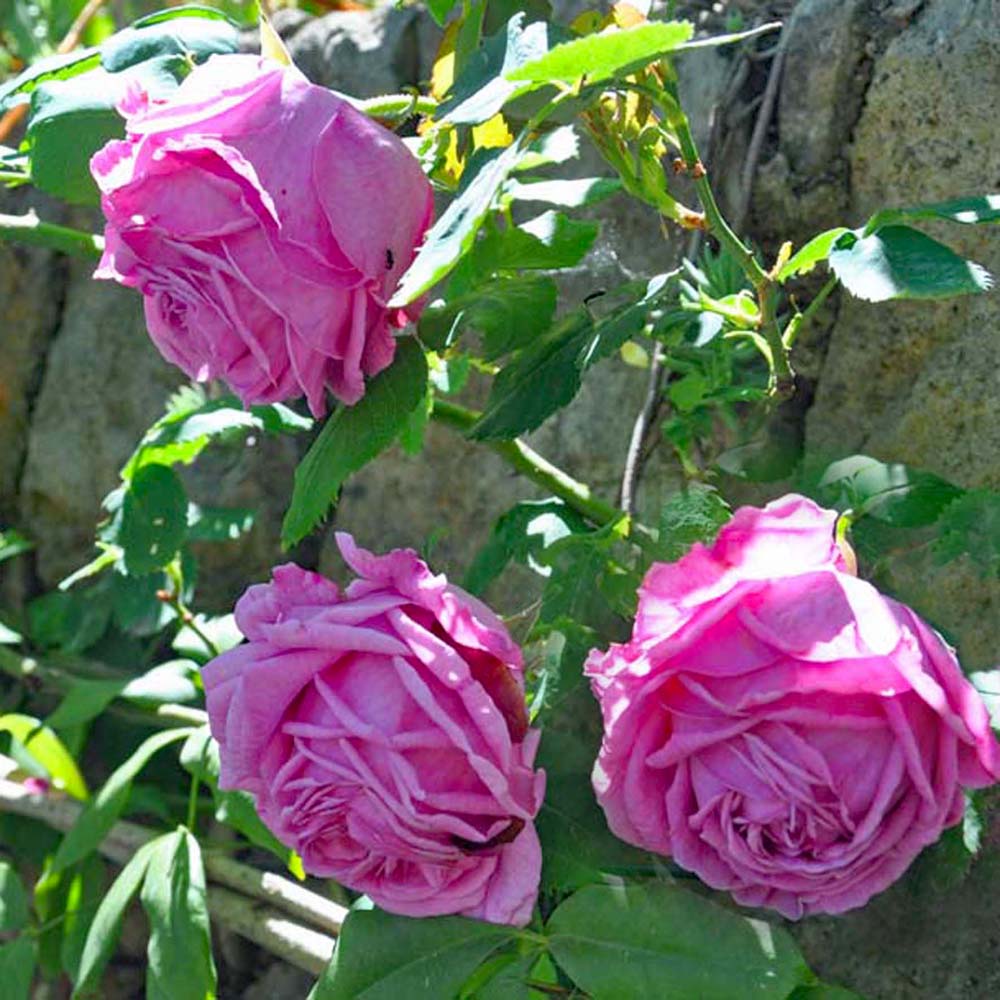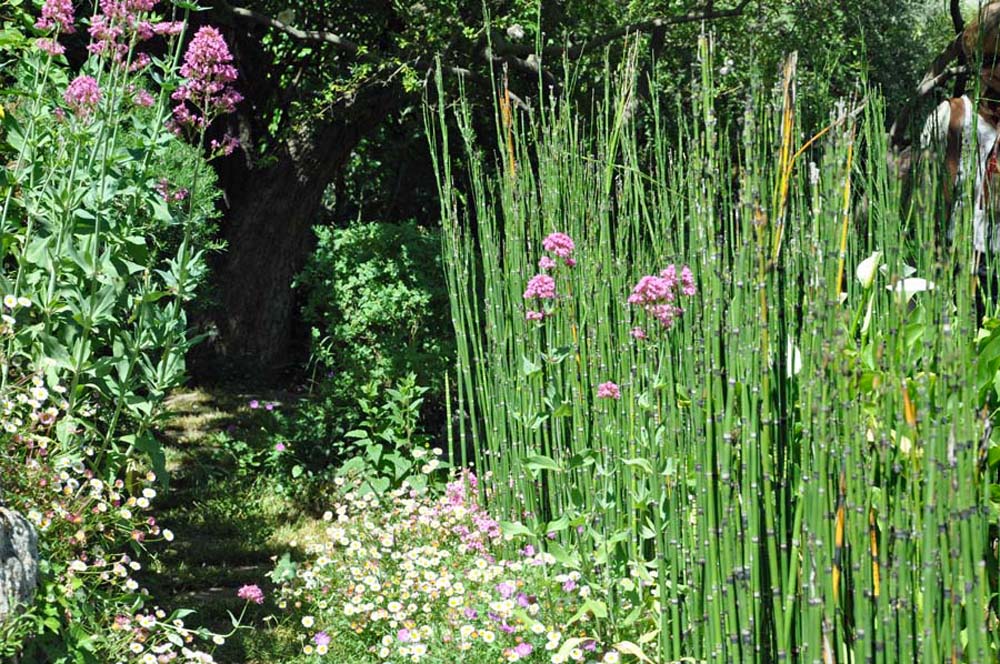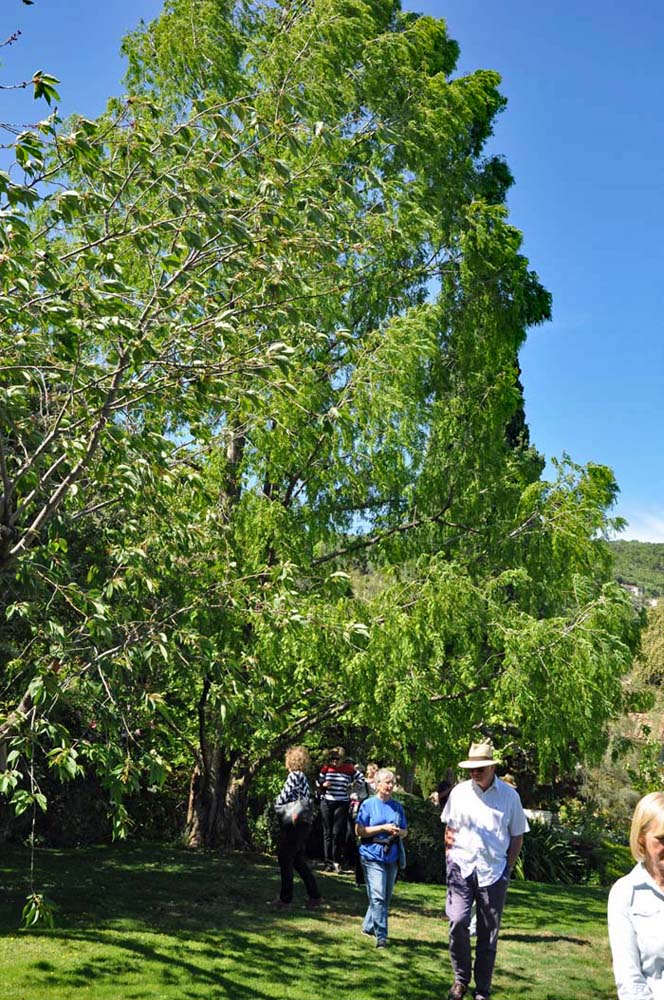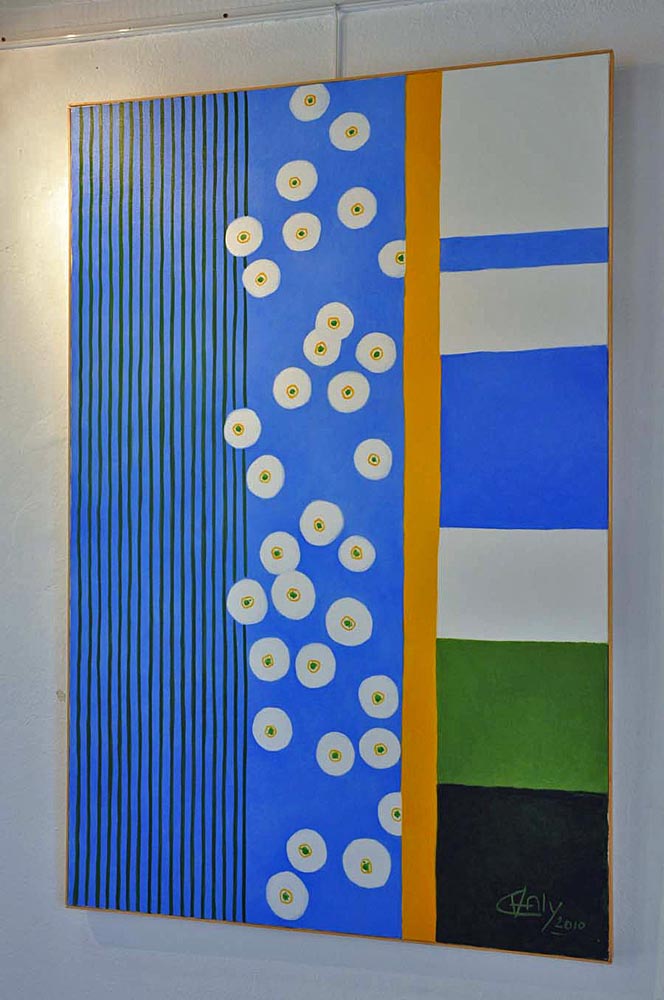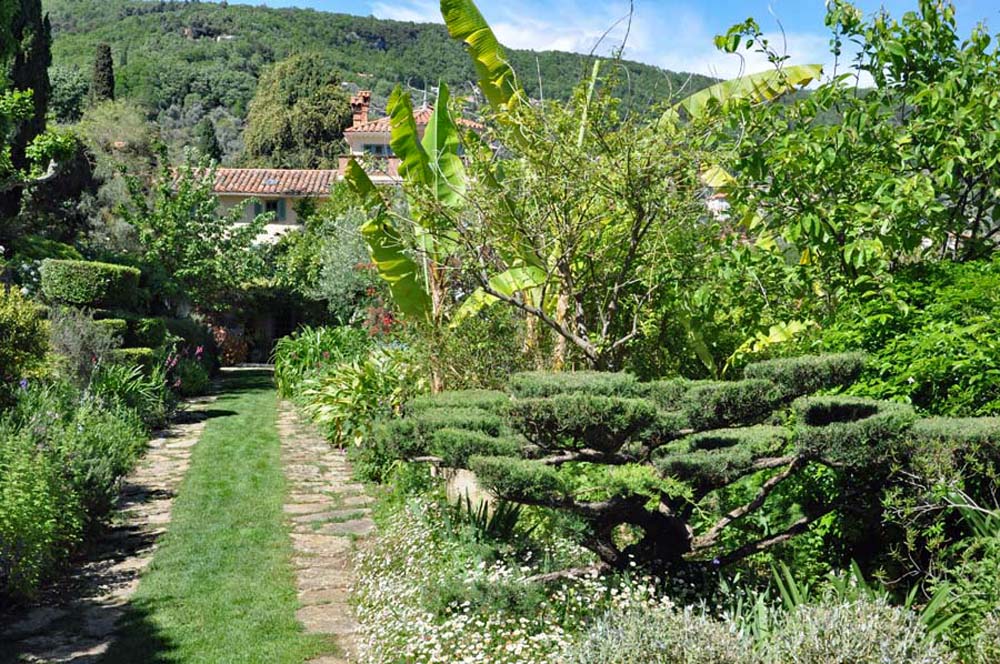May / mai 2016 – A rose baptism and visits to gardens
Le baptême d’une rose et visites de jardins près de Grasse, Alpes-Maritimes
Two days in the Alpes-Maritimes / Deux jours dans les Alpes-Maritimes
Click on the images to enlarge them / Cliquez sur les images pour les agrandir
Rose baptism at La Prieuré
11 May 2016 was a very special and unusual day, marking as it did, the ‘baptism’ of a new rose for the charity, Rainbows4children, under the aegis of Mediterranean Gardening France. The rose was created by obteneur de rose, Dominique Massad, and rose grower, Jean-Pierre Dittière. MGF member Joanna Millar, whose extraordinarily lovely garden, La Prieuré, in Tourrettes-sur-Loup, is home to a wonderful variety of roses, had very generously offered to host the event.
We were not blessed with good weather and umbrellas were much in evidence during the first part of the event, however the prosecco, kindly provided by Joanna, ensured that our spirits were not dampened. MGF President, Christine Daniels, welcomed the around 60 attendees and thanked Joanna for lending her beautiful garden for the ceremony, and for organising lunch.
Christine then introduced Max and Kathryn Robinson, the creators of the Rainbows4children foundation, and Dominique Massed, the creator of the rose.

Kathryn explained that Rainbows4children is an independent foundation set up in memory of Nicolas Robinson (Max’s son), which provides education for underprivileged children in the town of Mekele, in Tigray, a very poor region of Ethiopia. The Nicolas School, founded in 2005, now educates 1300 children from kindergarten to secondary school and is currently considered to be the best in Tigray and amongst the best schools in Ethiopia. The pupils are primarily the children of adults with disabilities such as loss of limbs and blindness. Those who were in kindergarten when the school was created are now about to leave, many of them going on to universities.
Partly as a result of Kathryn’s experience in the perfumery business, the idea of creating a rose to be sold to benefit the foundation was born. Max and Kathryn see it as a beautiful symbol of their efforts to break the chains of poverty in Ethiopia through education, as well as a reflection of the innocence, resilience and beauty of children. Although developed in the Loire valley, the new rose has characteristics which make it suitable for growing in the Mediterranean climate conditions of southern France. Lemon yellow in colour, it is a highly fragranced rose, with citrus top notes and deep, warm undertones. Potted roses were available for sale with 50% of the sales price going to the foundation, and many of us were eager to buy.
The cake was cut and glasses raised to toast the newly baptised rose, the foundation, and all those who had contributed to the project.We were then free to enjoy the delicious finger buffet lunch, to talk with Kathryn and Max, as well as to Dominique Massad, the creator of the rose, and to explore Joanna’s garden.
The garden is on several levels, demonstrating once again, the importance of structure. The visitor is led along grassy paths between thickly planted borders, steps leading from one level to another. The proximity to the sea means that the climate is relatively mild and humid, so roses grow particularly well, as well as many varieties of shrub which are too tender for those of us who live further north. In English style, roses are combined with shrubs, herbaceous perennials and annuals, resulting in a relaxed, informal style and a profusion of colour and texture.
Joanna describes her garden thus:
“Roses are of great interest here. Many have come from England: Rosa ‘Constance Spry’, R. ‘Seagull’, R. ‘Rambling Rector’, R. ‘Cecile Brunner’ and R. ‘Bobby James’. Others, such as Rosa ‘General Schablikine’, and Rosa banksiae ‘Lutea’ were here when we arrived. We don’t prune climbing roses, only cut out dead wood, and let them romp up cypress or olive trees. Other shrubs are trimmed but allowed as much freedom as possible to give a natural and luxuriant look to the garden.”
Some roses in flower for our visit:
Members and guests enjoying the event…
Text: Frances Horne
Photographs: Pierre Escoubas
For further information, visit these websites:
The Rainbows4children Foundation
Dominique Massad
Jean-Pierre Dittière, Roseraie Doué-la-Fontaine
La Mouissone
The first impression at the gates of La Mouissone was one of a cliff held together by greenery and indeed Maggie Lockett has planted up the base of the cliff and has made pathways in the steep slopes using railway sleepers and other supporting materials. The weather, rather misty and moist, was not helpful for a full appreciation of the planting, but this is a varied garden with lots of interest.
The garden is relatively narrow because of the cliff and the steep slope to a road, but much has been made of the length and the variety of plants and shrubs.Among the most impressive were the tall, deep blue sage, Salvia guaranitica, the long purple stems of Salvia nemorosa, a rich, dark salvia, S. x jamensis ‘Nachtvlinder’, delicate pink Jasminum polyanthum and the massive, flower-filled stems of Echium pininana. Also of note was the Southern Hemisphere garden.
Along some of the paths and next to walls, the blue-flowered annual, Phacelia tanacetifolia, had self-seeded and formed attractive clumps, much appreciated by pollinators such as honey bees.
There was to have been a demonstration of pruning, but the wet conditions made this impossible.Instead we were able to follow in detail the work with summer vegetable plants which two gardeners were carrying out in a textbook plot. After the garden tour, tea and cake was served in a large and solidly built marquee-like structure and one had the opportunity to buy homemade jams and olive oil.
Text: Jason Spencer-Cooke
Photos: Jason Spencer-Cooke and Christine Daniels
Le Domaine de St Jacques de Couloubrier
Members of Mediterranean Gardening France were privileged to be offered the opportunity to stay at Le Domaine de St Jacques de Couloubrier for two nights during our visit to a number of gardens local to the Grasse area.
Le Domaine is an extraordinary place on a range of fronts. Firstly, it boasts one of the few Côte d’Azûr water gardens designed, in the mid-1950s, by one of the most legendary gardeners and landscapers of the 20th century, the Englishman Russell Page and widely featured in his book ‘The Education of a Gardener’.
Secondly, the current owners, Caroline Butt and her husband Stephen, bought the 8 hectare estate when it was, literally, a crumbling pile and they had no idea there was the vestige of one of Page’s celebrated gardens trapped within the overgrown landscape.
Thirdly, the Butts bought the property in 2001 when it had been unoccupied for 16 years. So they were obliged, literally, to pull the whole house down as it was too far gone… And so, what we see now is a fantastic re-build and triumph of engineering and land moving, authentically and lovingly re-created in every detail. The demolition of the house alone took seven months and construction of the new shell a further six, with the fit-out a final eleven months.
By then 98 windows had been installed, 150 doors of about 25 different types and 75 pairs of curtains using 70 different fabrics. No expense has apparently been spared and in the garden equally so. This is tended under the expert eye of Pierre Jeanjean, formerly gardener for the Elysée Palace, assisted by his team of five gardeners.
Le Domaine has a distinguished history: it was built in the mid-1800’s and the almost magical and atmospheric sunken garden dates from 1870. (This again was re-discovered by the Butts under years of brambles, and lovingly restored).
The property then passed to publishing magnate Jean Provost, the owner of Paris Match, in the 1940s when he transformed Le Domaine so as to be able to entertain lavishly the celebrities of his day including such stars as Sophia Loren…
Notwithstanding the undeniable luxury of the house and adjoining buildings it is the garden that is the real gem. The happenstance of the water garden, the Butts describe, was like discovering a lost old master. Further research uncovered designs and technical drawings for the water system in Page’s archive in Belgium. The inspirational water garden is still therefore flanked by pencil cypresses on either side and descends from an upper pond with an impressive water fountain down a series of falls and bassins (one of which is actually the swimming pool) before settling in a beautiful lily pond with a lovely arcade along its base-line.
During the renovation over 400 trees were planted straightaway and many others have followed.
As you can see on the plan the estate now includes, a woodland arboretum, a tree fernery, a bog garden, a dry garden, a perfume garden, a formal parterre à la française, an oliveraie, a potager and the newly planted rose garden.
The rose garden holds a national collection of Nabonnand roses, celebrated from before the First World War, and now returning to favour amongst discerning local garden owners for their old fashioned style but equally for their ability to prosper in the Mediterranean climate.
Some Nabonnand roses flowering during our visit:
and one created specially for the garden:
Homes and gardens such as these are usually the domains of kings and queens but our time at Le Domaine gave us the opportunity to feel like princes and princesses – if only for two days!
Text: Sara Robinson
Photos: Sara Robinson and Christine Daniels
Le jardin de la Villa Fort-France
This was a wonderful visit to a painter’s garden. The warm and well-communicated passion of the owner, Valérie de Courcel, contributed greatly to the quality of the visit.
Ce fut une merveilleuse visite d’un jardin d’artiste-peintre. L’accueil chaleureux et la passion communicative de la propriétaire Valérie de Courcel ont beaucoup contribué à la qualité de cette visite.
The history of this 5600 m2 garden located in Grasse began in 1930. Lady Fortescue, an actress, and her husband, the historian Sir John Fortescue, formerly Royal Librarian and Archivist, decided to settle in the south of France where they bought what was, at the time, a small sheep barn. Lady Fortescue structured the main lines of the garden and installed a rose garden. She began her writing career by describing the management of the property in a book, “Perfumes of Provence”.
L’histoire de ce jardin de 5600 m2 situé dans Grasse commence en 1930. Lady Fortescue, actrice, et son époux l’historien Sir John Fortescue, ancien Bibliothécaire et Archiviste royale, décident de s’établir dans le sud de la France où ils achètent ce qui était une petite bergerie. Lady Fortescue structure les axes principaux et installe une roseraie. Elle commence une carrière d’écrivain en racontant l’aménagement de cette propriété dans le livre « Perfumes of Provence ».
Subsequently the domain was taken over by a pharmacist with a passion for gardening, who brought back a collection of plants from her extensive travels. In 1992, Valérie de Courcel and her husband took over the property. Lacking knowledge of gardening techniques, they learned on the job. Today the two of them still take care of the garden without help, working both as artists and artisan gardeners. They decided to stop using pesticides although it took three years before birds and insects took up residence in significant numbers.
Par la suite, le domaine sera repris par une pharmacienne passionnée qui constitue une collection de plantes qu’elle rapporte de ses nombreux voyages. En 1992, Valérie de Courcel et son mari reprennent la propriété. Ignorants des techniques de jardinage, ils apprennent sur le tas, Actuellement, ils sont encore seuls à prendre soin du jardin, à la fois artistes et artisans jardiniers. L’utilisation des pesticides a été arrêtée, il a fallu 3 ans pour que s’installent insectes et oiseaux en nombre.
The structure and colours of the garden are decided by the painter’s eye of Valérie de Courcel. Several factors contribute to the feeling of freedom and joy which is evident as soon as the visit begins: the wide variety of both wild and rare plants mixed colourfully together, the Nabonnand roses climbing through the trees, and the overall appearance, resulting from the way Valérie de Courcel structures and then deconstructs the spaces.
La structure et la couleur de ce jardin sont déterminés par le regard de peintre de Valérie de Courcel. Plusieurs éléments contribuent à la sensation de liberté et de joie qui s’impose dès le début de la visite : La grande variété de plantes sauvages et des plantes rares se mêlant en palettes multicolores, les rosiers Nabonnand se glissant dans les arbres et l’aspect général qui résulte du travail de Valérie de Courcel en structurant puis déstructurant l’espace.
The garden is terraced. The entrance is at the bottom and one climbs from terrace to terrace to reach the house.
Le jardin est organisé en terrasses. L’entrée se fait par le bas et l’on monte de terrasses en terrasses vers la maison.
After a first terrace bordered on one side by olive trees and on the other by a box hedge in front of yew trees and low-growing plants, one comes upon two pools connected by a small canal with constantly flowing water. Further on, an arbour is entirely covered by the foliage and flowers of a single Rosa gigantea.
Après une première terrasse bordée d’un côté par des oliviers et de l’autre de buis placés devant des ifs et des plantes basses, on débouche sur deux bassins reliés par un petit canal où l’eau est toujours en mouvement. Plus loin, une tonnelle est entièrement couverte par les branches d’un seul pied de Rosa gigantea.
We admired a beautiful and rare passion flower, Passiflora antioquiensis, native to the tropical forests of Colombia, with pinky-red flowers and roses, R. ‘Bobby James’ and R. ‘Mme Isaac Pereire’.
Une belle et rare passiflore originaire des forêts tropicales de Colombie : Passiflora antioquiensis à fleurs rose-rouge et des rosiers Bobby James et Mme Isaac Pereire.
On another terrace was a small wild-looking pond and near the house, in front of the pool, a stone bench runs along a wall covered with aeoniums.
Sur une autre terrasse, un petit bassin d’aspect sauvage. Près de la maison, devant la piscine un banc de pierres est adossé à un mur d’Aeonium.
The terrace situated just above the house is home to a beautiful rose garden, in the same position as that cultivated by Lady Fortescue. Annuals planted amongst rose bushes bordered by box hedges bring the scene to life, breaking the monotony which one sometimes sees in rose gardens.
La terrasse située un peu au-dessus de la maison est occupée par une belle roseraie, là où était celle de Lady Fortescue. Au milieu des roses bordées par des buis, des annuelles animent l’ensemble en brisant la monotonie résultant parfois des alignements de rosiers.
Next, two surprises await us. First, on a terrace near the house, two plane trees have had several branches grafted together to form a living arch.
Deux surprises nous attendent ensuite. D’abord, sur une terrasse proche de la maison, deux platanes avec plusieurs branches greffées les unes aux autres pour former une voute végétale.
The second surprise is a large tree, Metasequoia glyptostroboides. This species has an unusual history. Metasequoia were thought to be extinct and only known as fossils. But in 1941 living specimens were found in China and in 1948 seeds were sent to the Arnold Arboretum at Harvard which redistributed them to other arboretums and institutes. The first French Metasequoia was planted in 1948 in the Alpine Garden Museum of Natural History in Paris. The Villa Fort France tree was planted about 50 years ago.
La 2ème surprise est un grand arbre, Metasequoia glyptostroboides. Cette espèce a une histoire peu commune. Les Metasequoia étaient considérés comme fossiles. Mais en 1941 des exemplaires vivants ont été trouvés en Chine. En 1948, des graines furent envoyées à l’arboretum Arnold d’Harvard qui les redistribua à d’autres arboretums et instituts. Le premier Metasequoia français a été ainsi planté en 1948 dans le jardin alpin du Museum d’Histoire Naturelle de Paris. Celui de Fort-France aurait été planté il y a environ 50 ans.
At the end of the visit, some of Valérie de Courcel’s artworks are on view in a small gallery. She provides some explanation of her works, for example ‘Essence‘ is inspired by Japanese anemones. The flower has been deconstructed to show the stiff stems, round flowers and coloured leaves.
A la fin de la visite, quelques œuvres de Valérie de Courcel sont exposées. Elle fournit quelques clés de lecture. Ainsi l’œuvre présentée ci-dessous, « Essence » est inspirée par les anémones japonaises. La fleur est déstructurée avec les tiges raides, les fleurs rondes et les couleurs des feuilles.
Finally, to round off this wonderful visit, a photograph of the house at the end of the path.
Enfin, pour terminer cette belle visite, une vue de la maison au bout de l’allée.
Texte, traduction en anglais et photos : Roland Leclercq
![]()

